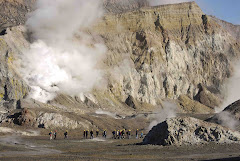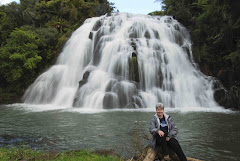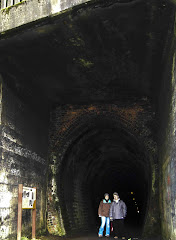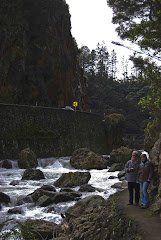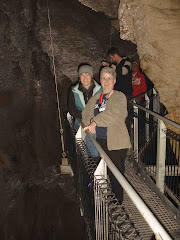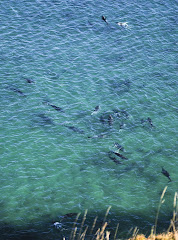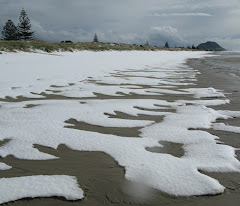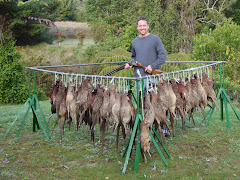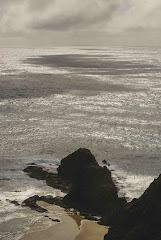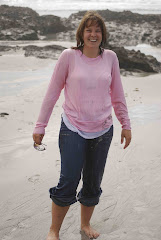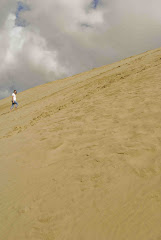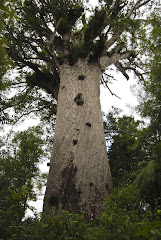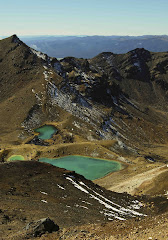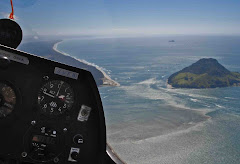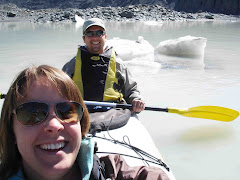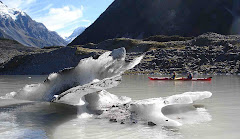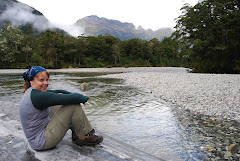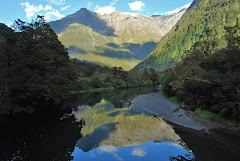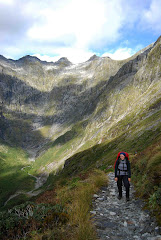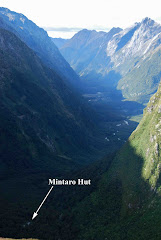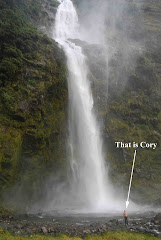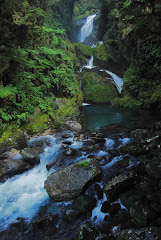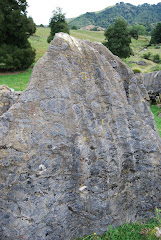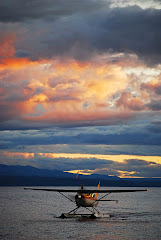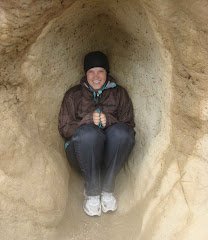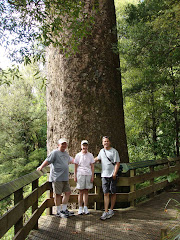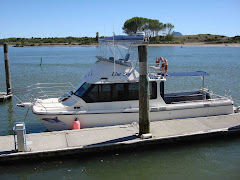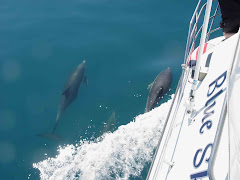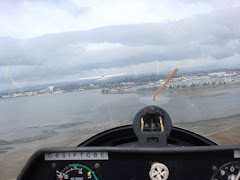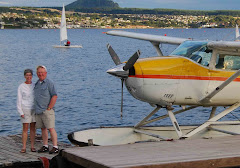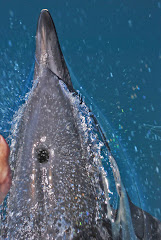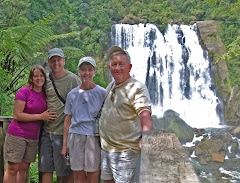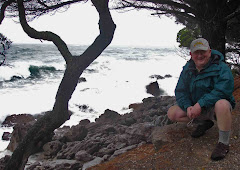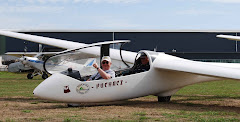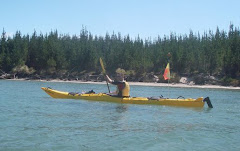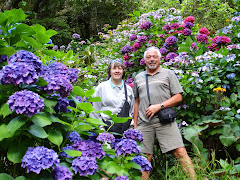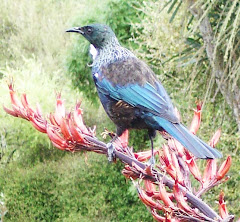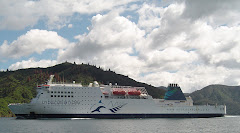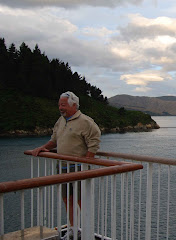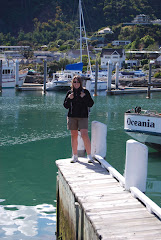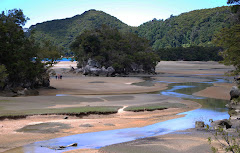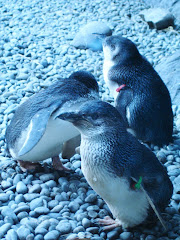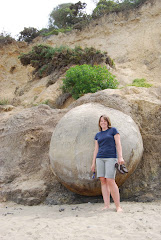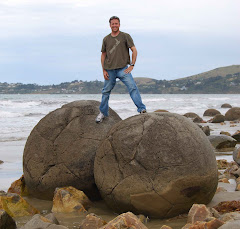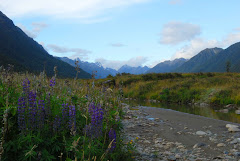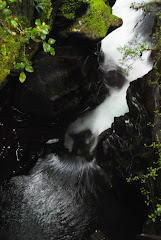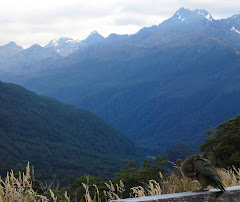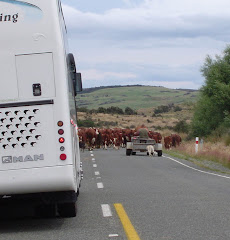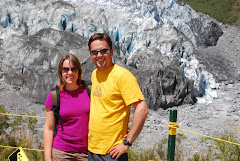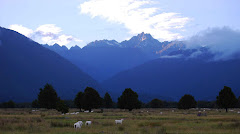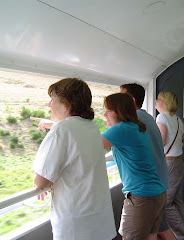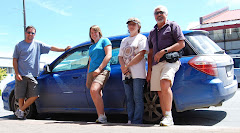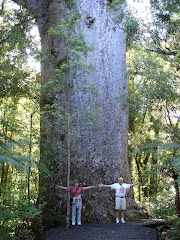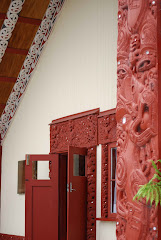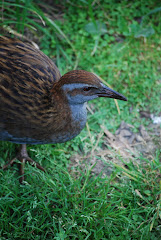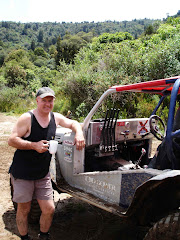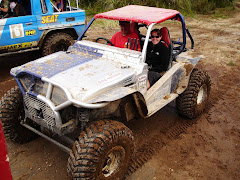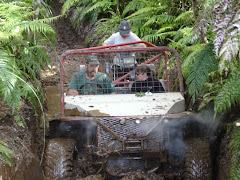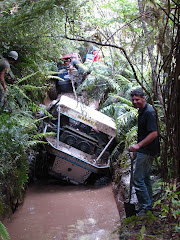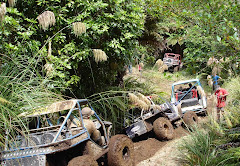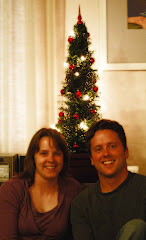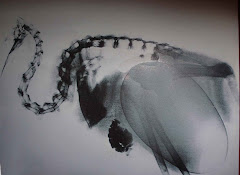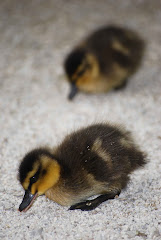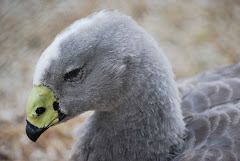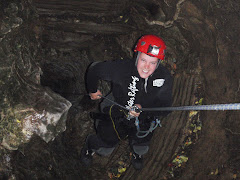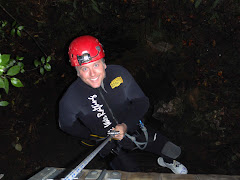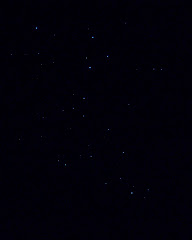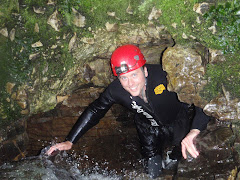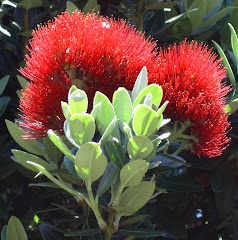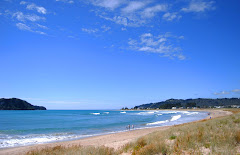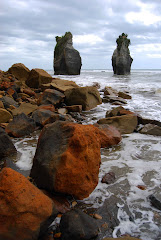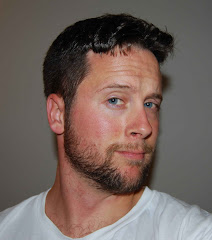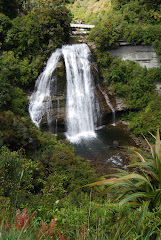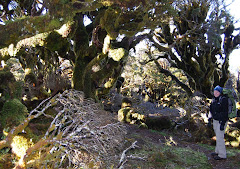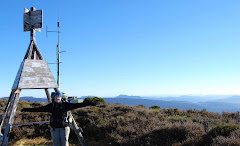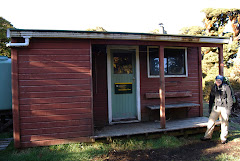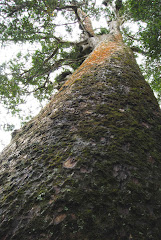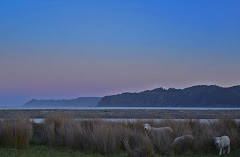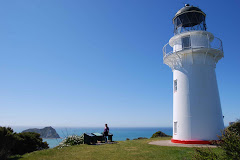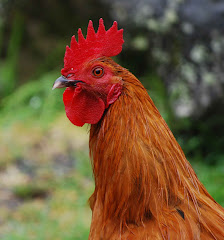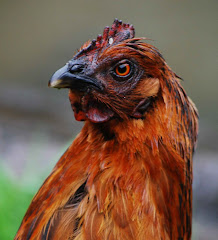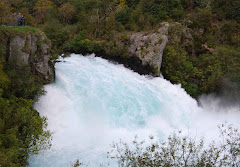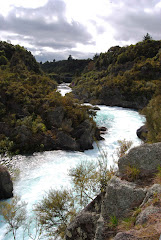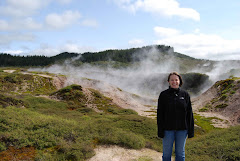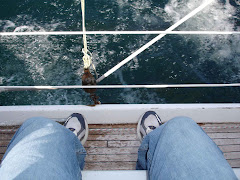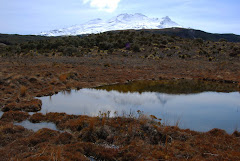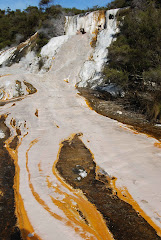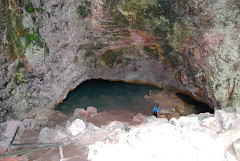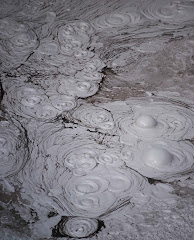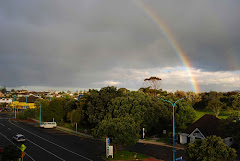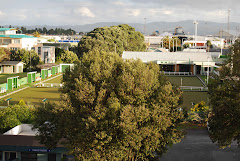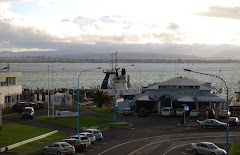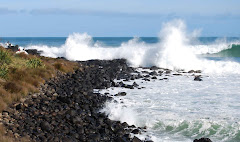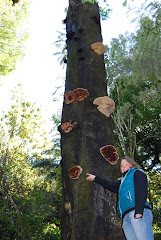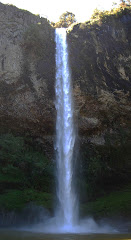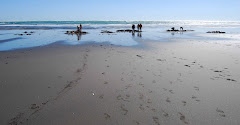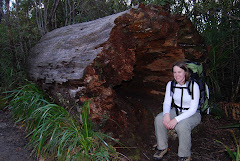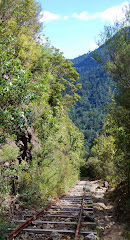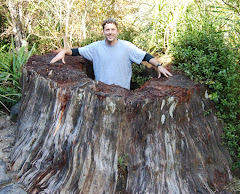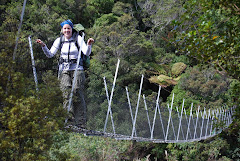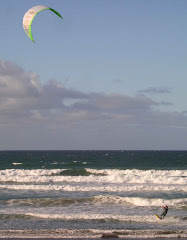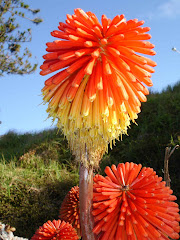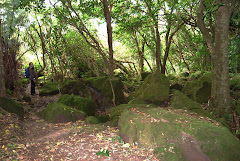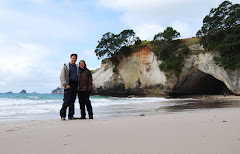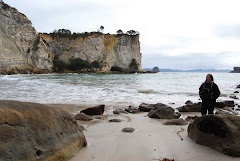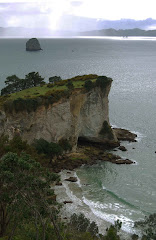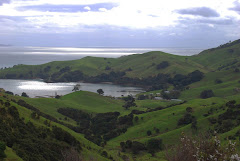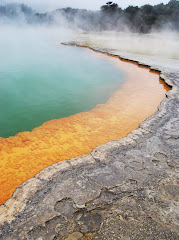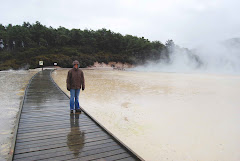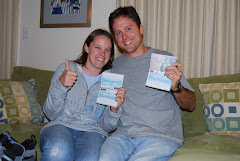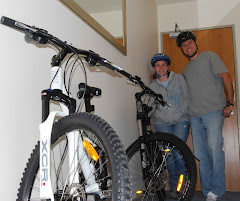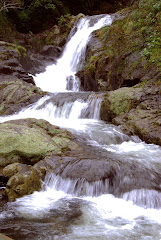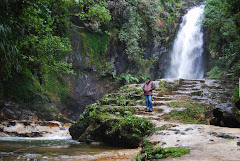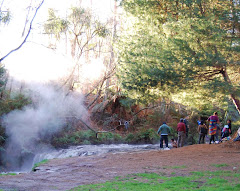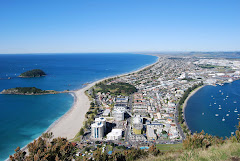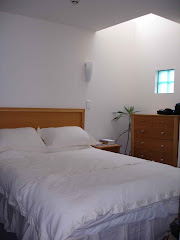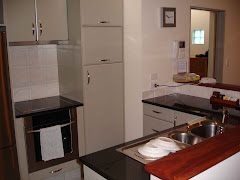(Warning: This blog post is extreme in length, and may cause the reader to become drowsy and/or attached to the seating beneath them.)
We recently got back from our 10-day trip to New Zealand’s South Island. Cory and I have been wanting to go, and my parents had some of the South Island sights on their “must-see” list, so their trip was the perfect impetus.
I should start of by saying that I got little input from the others on our trip; Mom and Dad were pretty overwhelmed with planning their trip to NZ all ready, and Cory isn’t big on advance decision making when it comes to travel. I’d heard that during the summer months, it could get quite crowded in the South Island, so it was advised you book accommodations, etc well ahead.
So with that warning ringing in my ears and too many guide books to peruse, I started planning this trip in October; I know that this is very dorky, but I couldn’t help myself. There is a lot to see in the South Island and everyone has their input on what spots you “have to go to”. I was perhaps a little over-ambitious in mapping out our route. But there really are so many places you “have to go to”! Turns out that, on top of two airplane flights, a three-hour ferry ride, and a cross-country train journey, we also drove 2505 kilometers. (For those of you who don’t do metric, that is about 1500 miles.) Most surprising, during our trip, no one tried to strangle me or push me out of the moving car!
We pretty much circumnavigated the South Island, though we did cheat, and cut off the very southern tip. (I’d planned to go there, but got a sense from my traveling companions that it might have to be sacrificed in the name of sanity.) I have decided against giving you a detailed, day-by-day account (though I did keep a “paper blog” so I could do so upon request) and will instead try to narrow it down to the highest of highlights…
Flying south into Wellington, the nation’s capital, at the very tip of North Island, was pretty much like taking a scenic flight – you could watch the orchards pass by, get a great view of giant Lake Taupo, and see into the craters of the Tongariro Mountains. Wellington itself is the coziest larger city we’ve been in since arriving in NZ. There just aren’t that many large cities, with a national population of 4 million. Auckland has a population of about 1 million, making it decidedly un-cozy.
We hit a great museum, Te Papa, which had something for everyone – modern art, historical artifacts, natural history displays, cultural exhibits… Then we took a cable car up to the botanical gardens, and spent the afternoon wandering along, not minding if we didn’t know exactly where we are at. Anytime you can get lost in a garden, you are in a good place. The day was topped off by Cory’s selection of a pizza place that actually satisfied his craving for pizza as it should be.
We enjoyed the city more the next day, visiting a farmer’s market, watching street performers, eating crepes, poking around in shops, and hoping our taxi driver wouldn’t run down the pedestrians. We did make it safely to the ferry terminal, where we boarded the Arahura. We sailed, peering out the salt-sprayed windows with binocs, across Cook Strait. Mom and I toasted the evening’s trip with a glass of wine just before we came into port.
We picked up our rental car the next morning, along with some groceries for lunches on the go. Then we took a small boat through the Queen Charlotte’s Sound, before our short hike. We spotted several wekas, which are little brown birds that sort of resemble a chicken, but are very inquisitive and, apparently, fairly oblivious. One walked right by Mom, on a little footpath, before spotting me. After a picnic lunch, the plan was for another boat to pick us up and return us to the wharf that we’d departed from that morning. Apparently, though, the “water taxi” run by this same company had broken down, and the boat we were on was doing double-duty. We stopped at every bay and cove imaginable. (And, sometime, when you’ve got the atlas out, look at that northeastern coastline of the South Island – there are more than a couple of bays and coves!) It was neat, though… We took people home from work, dropped folks off at their holiday cribs, watched a woman unload boxes of groceries bought in town, and, in general sailed slowly back and forth among the sounds for about three hours.
The next day we had sort of a similar water cruise/hike in the Abel Tasman area. And, before we even got on the boat, we saw a little blue penguin playing in the surf! We spotted a few fur seals, too, lazing on the rocks in the sun. The rest of the day did not disappoint either, with plenty of sandy beaches to explore and rainforest-like bush to wander through.
The next morning, we caught part of a newscast of Obama’s inauguration; people in New Zealand are almost as excited as Americans about our new president! After that good start, we drove into Christchurch to see the International Antarctic Center. Christchurch is the shipping off point for many people working and studying at the South Pole. The Center had some really great displays, including educational displays, a mock camp set-up, a home for injured penguins, a “cold zone” (where they had real snow, cold temps, and wind like Iowa’s)!
After another little drive, we stopped to see the Moeraki Boulders. We have pictures, which do give you some sense of scale, but it’s difficult to do these unusual, spherical rocks, strewn along a beach justice in a description. Some use the term “other-worldly”, which isn’t really right. Maybe you’ll just have to come see them for yourself.
Then that evening, we went to a penguin blind at Nugget Bay. The very rare yellow-eyed penguins often nest here, and we were hoping to see some. We had our binoculars and cameras, and we were able to put them to good use! We saw at least eight penguins come in from the ocean and toddle up to their nests in the rocks or the grassy slope! We were also able to spot 2 seals, one lazing on the shore and the other playing (or hunting) in the surf of the bay.
In the morning, we decided to see if we could keep our luck going and headed to Surat Bay. We took a short walk along the grassy slopes above the beach, on our way to look for sea lions. To our surprise, Mom actually spotted one in the grass that Cory and I had walked right by – within a meter of it, probably! Luckily for us, it was sleeping, and we hadn’t woken it. Rumor has it, sea lions do not like their naps interrupted. Down on the beach, we saw another one, and could see flipper tracks in the sand of many more sea lions that had come into nap.
Our next destination was the Milford Sound area on the southwestern coast. (If you are following on a map, and please tell me you’re not, we’d by now traveled much of the short, northern coast and all of the eastern coast of the South Island. And everyone was still speaking to me…) During our drive across the Canterbury Plains, Mom snapped photos from the car – sheep, sheep, deer farms, sheep, hedges, sheep, hedges, tussock, hedges, and sheep mostly. We stopped that afternoon to do laundry and take a break from the road. We ended up having dinner at an Italian place (another good pizza for Cory) before heading off again.
While the Sounds themselves are the highlight, the drive towards them is almost as impressive. We stopped at one lookout to get a better glimpse of the mountains, and were greeted by a kea, the only alpine parrot. They are nosy and sociable birds, legendary for picking apart windshield wipers as cars wait in line to enter the Homer Tunnel (a narrow, one-lane tunnel – always a really good idea). We also encountered a somewhat less likeable animal, the infamous sandfly. Small and mean, these little buggers could just about drive you mad. I’m sure they have actually driven someone mad at some point, and I came close to joining them. I am still scratching at bites and occasionally have a flashback and begin swatting at myself.
Milford Sound is actually a fiord (yes, they spell it with an “i” not a “j” here), the difference being that sounds are carved by rivers heading towards the ocean, whereas fiords are carved by glaciers and then filled in by ocean waters. (Save that little tidbit of info for trivia night!) After a rain, the walls of the fiords have over 10,000 waterfalls cascading down them. We saw a pretty good selection of them the day we visited and were even spared the rain!
On our walk from the car park, Mom spotted another pretty rare penguin, the Fiordland Crested. Again, Cory and I would have walked right on by. Thank goodness Mom sees these things! We also saw three groups of seals, dusky dolphins, and Australian gannets out in the fiords. Then, we stopped off at Milford’s Underwater Observatory. Because of the unusual layering of tannin-stained freshwater layering over salt water in the Milford Sound, sea creatures that are normally found at a much greater depth are visible only a few meters under the surface. To view these, the Underwater Observatory was built, letting the public venture a few stories underwater to see things like sea cucumbers, eleven-legged starfish, snake starfish, rare black and red coral, tube anemone, a variety of fish, and even squid eggs!
After a full day, we drove northwards to Queenstown, and then, the next day, on toward the Fox Glacier. No where else are there such easily accessible glaciers surrounded by such lush forests. We walked a short half-hour to get within 80 meters of the terminal face of the glacier – as close as you would want to get due to avalanches and rock slides. We heard rocks or ice fall from the glacier as we stood there, taking in the blue, blue ice and the piles of snow.
The Franz Joseph Glacier is just a bit further north. We hiked over a rock-strewn river bed to within 200 meters of its terminal face. This allowed a view back into the steep-sided walls that held the glaciers bulk. The areas for visitors are well-marked, and, as we stood their gawking at it, a group of guides came marching past. They lead groups out on areas of the glacier and, with their red shirts and large pick axes, were going out to scout out the safest routes. We enjoyed the view from where we were.
We then drove on towards Greymouth, where we dropped off the car and caught the train. The TranzAlpine crossed the island from east to west and back each day. On its route over the Southern Alps, it crossed over four viaducts and nineteen tunnels. Standing in the open-air observation car while passing through a tunnel offered a childish thrill (and left me lightly coated with black soot)!
The next morning we breakfasted at Drexel’s in Christchurch, where they had “Iowa Pancakes” on the menu. The original owner used the pancake recipe of his Iowan grandma – a taste of home! Not only were they delicious, but they gave us enough energy to explore the campus of the Arts Center all morning. We caught a taxi in enough time to get us to the airport for our flight back to Tauranga.
Whew!
Friday, January 30, 2009
Thursday, January 29, 2009
South Island Trip: Abridged Version
We recently got back from our 10-day trip to New Zealand’s South Island. Cory and I have been wanting to go, and my parents had some of the South Island sights on their “must-see” list, so their trip was the perfect impetus.
It was a really great trip, and we saw a lot of cool stuff. We also drove sort of a lot…
It was a really great trip, and we saw a lot of cool stuff. We also drove sort of a lot…
Thursday, January 22, 2009
South Island exploring
We've been traveling the South Island these past five days - we started in Wellington then took the ferry through Cook Strait to Picton. Lots of adventures to tell, but we'll save those for a lengthier post when we return. Mom and Dad are easy-going travelers, and no one has become physically violent towards the tour guide (me) yet - all good signs!
Friday, January 16, 2009
Touring Tauranga
Mom and Dad have been here this week and we’ve been exploring the Tauranga area and beyond. I’m trying to take it easy on them, hoping they’ll be prepared for our 10 days traveling in the South Island. (I’ve created an itinerary that has been referred to as “grueling” – but there is so much to see! I may give up this whole teaching thing and focus on tourism instead.)
After our nice weekend, Cory had to return to work, while Mom, Dad, and I filled our days with touristy activities. It’s been fabulous – we’ve taken a million pictures or so, too...
Monday: Dad and I ran along the beach in the morning. After breakfast, we hit the road. Our first stop was a local garden shop. Mom and Dad have been identifying plants left and right. Then we went to Mossop’s Honey, where, after a long time spent chatting with the clerk, she sent us out the door with ice cream cones (“Well, you can have that, but let me just put a little taste of this…and this…and this… There!”) With full bellies, we headed into town to the Tauranga quilting shop. Mom found some great fabric, and a Kiwi quilt is in the works. In the afternoon we checked out the tide pools and the wharf during low tide. We spotted crabs, jellyfish, and, most exciting, a sting ray!
Tuesday: We hiked up to the summit of Mount Maunganui in the morning. The walk was a little steep, but the views were great. We rewarded ourselves with giant ice cream cones from Copenhagen Cones at 10:30 in the morning. (There was no line, though, and this is unheard of – you have to take the advantage when opportunity knocks. Plus, that was a long walk up!) After recovering, we got hopped on a bus and took a tour of the Port of Tauranga. It was really fascinating. Afterwards, we shopped in downtown Maunganui, picking up souvenirs and postcards.
Wednesday: We headed out over the Kaimai mountain range towards the west. Our first stop was the Gordonton quilt shop, where Mom picked up more fabric for her quilt. Then we headed to the Hamilton Gardens. It was a perfect day to wander around the gardens, but Dad burned the top of his feet after insisting that he was going to wear his sandals all day. That night, Mom and Dad had their Burger Fuel “experience” – they, too, are hooked.
Thursday: Dad and I skipped our run this morning, instead opting for a coffee at a café. Then we suited up and headed to the beach. Dad and I tried to ride in on the waves, while Mom people-watched. That afternoon, Dad napped (worn out from all that surf) while Mom and I checked out the local Department of Conservation office and searched for plant guides. That night we ate dinner on the deck before heading to the Mount Hot Pools.
Friday: A cruise ship had arrived early this morning and Mom and Dad were awed with its size. After a quick run around the Mount, we did some laundry and started to pack for our big South Island trip. In the afternoon, we hopped on the Spirit of Tauranga, a ferry that runs between the Mount and Tauranga. We had a great ride, with fantastic views. For dinner, we ate at the Lobster Club. Dad and Cory had the fresh fish, while Mom and I split the seafood platter for two. It should have been listed as seafood platter for 4+, but with help, we did manage to do some damage – crayfish, crab legs, prawns, shrimp, scallops, oysters, mussels, pipis, salmon, tuna, snapper… Oy!
After our nice weekend, Cory had to return to work, while Mom, Dad, and I filled our days with touristy activities. It’s been fabulous – we’ve taken a million pictures or so, too...
Monday: Dad and I ran along the beach in the morning. After breakfast, we hit the road. Our first stop was a local garden shop. Mom and Dad have been identifying plants left and right. Then we went to Mossop’s Honey, where, after a long time spent chatting with the clerk, she sent us out the door with ice cream cones (“Well, you can have that, but let me just put a little taste of this…and this…and this… There!”) With full bellies, we headed into town to the Tauranga quilting shop. Mom found some great fabric, and a Kiwi quilt is in the works. In the afternoon we checked out the tide pools and the wharf during low tide. We spotted crabs, jellyfish, and, most exciting, a sting ray!
Tuesday: We hiked up to the summit of Mount Maunganui in the morning. The walk was a little steep, but the views were great. We rewarded ourselves with giant ice cream cones from Copenhagen Cones at 10:30 in the morning. (There was no line, though, and this is unheard of – you have to take the advantage when opportunity knocks. Plus, that was a long walk up!) After recovering, we got hopped on a bus and took a tour of the Port of Tauranga. It was really fascinating. Afterwards, we shopped in downtown Maunganui, picking up souvenirs and postcards.
Wednesday: We headed out over the Kaimai mountain range towards the west. Our first stop was the Gordonton quilt shop, where Mom picked up more fabric for her quilt. Then we headed to the Hamilton Gardens. It was a perfect day to wander around the gardens, but Dad burned the top of his feet after insisting that he was going to wear his sandals all day. That night, Mom and Dad had their Burger Fuel “experience” – they, too, are hooked.
Thursday: Dad and I skipped our run this morning, instead opting for a coffee at a café. Then we suited up and headed to the beach. Dad and I tried to ride in on the waves, while Mom people-watched. That afternoon, Dad napped (worn out from all that surf) while Mom and I checked out the local Department of Conservation office and searched for plant guides. That night we ate dinner on the deck before heading to the Mount Hot Pools.
Friday: A cruise ship had arrived early this morning and Mom and Dad were awed with its size. After a quick run around the Mount, we did some laundry and started to pack for our big South Island trip. In the afternoon, we hopped on the Spirit of Tauranga, a ferry that runs between the Mount and Tauranga. We had a great ride, with fantastic views. For dinner, we ate at the Lobster Club. Dad and Cory had the fresh fish, while Mom and I split the seafood platter for two. It should have been listed as seafood platter for 4+, but with help, we did manage to do some damage – crayfish, crab legs, prawns, shrimp, scallops, oysters, mussels, pipis, salmon, tuna, snapper… Oy!
Monday, January 12, 2009
Mom and Dad are here!
Our first visitors have arrived. I picked up Mom and Dad from Auckland Airport on Wednesday, just after noon. Their flight had gotten in a little early and I had been at the airport only 15 minutes before they were walking through the arrival gates. I had a clear view of them, and Dad spotted me right away. Mom, though, either didn’t see me or didn’t recognize me for awhile – I’m not sure which!
Their flight was as good as a horribly lengthy flight can be, minus a few issues at the customs (turns out you should NOT fill in those declarations with pencil). So we tossed their luggage in the car and headed off. Mom had really wanted to see the kauri groves, and some of the largest and oldest are in the Waipou Forests north of Auckland. Forget jet lag – we had things to do!
They tolerated my driving, mostly because they had no desire to drive themselves. Mom has pointed out, and I think she’s right, that when we come back to the US, we’ll be really confused about what side to drive on; neither will feel quite right, yet neither will seem wrong either. I hadn’t even thought about our re-introduction to driving in the US.
Our first stop was the Kauri Museum in Dargaville; it was good, but it was really just a warm-up for the real thing. On Thursday we drove through Waipou Forest, stopping along the way to take short walks in to see some of the most massive of the trees. Mom and Dad have been working to identify plant species, as I am almost no help at all. The only thing I can do is pronounce the names, many of which are Maori and involve one too many vowels for them just yet.
We also visited the Waitangi Treaty grounds that day. The history of the Waitangi Treaty is actually really interesting. The treaty is the document that created the nation of New Zealand, drafted by a British government representative who probably should’ve had more training in law and translated by a missionary who wasn’t sure how to explain concepts like sovereignty to a people who hadn’t needed the Queen’s assistance for the past 400 or so years. Today the treaty and its translations is still a source of debate in New Zealand. I was really excited to learn more, but it turns out the Waitangi Treaty grounds choose to focus on some different aspects. The treaty’s main author did have a lovely home with very nice gardens and there was a big ol’ party to commemorate the 150th anniversary of the signing of the treaty.
Friday we made our way home; I think Mom and Dad were glad to be out of the car and stationary for awhile. We gave them the grand tour on Saturday, complete with a trip to the Farmers’ Market, Fresh Bobby’s Fish Market for fish and chips, and a walk around the Mount.
Sunday we went down to Rotorua. There is a thermal area there that operates in conjunction with a Maori cultural experience. Whakarewarewa (and that is the abbreviated name) gives a great overview of some basic Maori culture and highlights some beautiful natural sights in the thermal areas.
And if that wasn’t enough, we went to Kiwi Encounter that afternoon. They run a facility dedicated to the preservation of New Zealand’s national bird, the kiwi. Kiwis are a noctural, flightless bird, and they are slowly becoming extinct. From egg to one year of age, kiwis have a 5% survival rate in the wild. At this age, they don’t have enough defenses from the non-native predators (stoats, weasels, possum, cats, and dogs) that are destroying their population. After one year, they are much more able to defend themselves and have a 60% survival rate. So the Kiwi Encounter takes eggs from kiwi nests, monitors them through incubation to the age of 1 year before releasing them back into the wild. They can assist with difficult hatchings, monitor their food intake, and implant the kiwi with a microchip for tracking. The best part of the experience, though, was getting to walk through their nocturnal room and see kiwis up-close. They keep a few birds that cannot be released back into the wild for breeding; these are the birds we saw and they were amazing. Very, very cool…
The best part of the weekend, though, has been having Mom and Dad here. How nice to see family!
Their flight was as good as a horribly lengthy flight can be, minus a few issues at the customs (turns out you should NOT fill in those declarations with pencil). So we tossed their luggage in the car and headed off. Mom had really wanted to see the kauri groves, and some of the largest and oldest are in the Waipou Forests north of Auckland. Forget jet lag – we had things to do!
They tolerated my driving, mostly because they had no desire to drive themselves. Mom has pointed out, and I think she’s right, that when we come back to the US, we’ll be really confused about what side to drive on; neither will feel quite right, yet neither will seem wrong either. I hadn’t even thought about our re-introduction to driving in the US.
Our first stop was the Kauri Museum in Dargaville; it was good, but it was really just a warm-up for the real thing. On Thursday we drove through Waipou Forest, stopping along the way to take short walks in to see some of the most massive of the trees. Mom and Dad have been working to identify plant species, as I am almost no help at all. The only thing I can do is pronounce the names, many of which are Maori and involve one too many vowels for them just yet.
We also visited the Waitangi Treaty grounds that day. The history of the Waitangi Treaty is actually really interesting. The treaty is the document that created the nation of New Zealand, drafted by a British government representative who probably should’ve had more training in law and translated by a missionary who wasn’t sure how to explain concepts like sovereignty to a people who hadn’t needed the Queen’s assistance for the past 400 or so years. Today the treaty and its translations is still a source of debate in New Zealand. I was really excited to learn more, but it turns out the Waitangi Treaty grounds choose to focus on some different aspects. The treaty’s main author did have a lovely home with very nice gardens and there was a big ol’ party to commemorate the 150th anniversary of the signing of the treaty.
Friday we made our way home; I think Mom and Dad were glad to be out of the car and stationary for awhile. We gave them the grand tour on Saturday, complete with a trip to the Farmers’ Market, Fresh Bobby’s Fish Market for fish and chips, and a walk around the Mount.
Sunday we went down to Rotorua. There is a thermal area there that operates in conjunction with a Maori cultural experience. Whakarewarewa (and that is the abbreviated name) gives a great overview of some basic Maori culture and highlights some beautiful natural sights in the thermal areas.
And if that wasn’t enough, we went to Kiwi Encounter that afternoon. They run a facility dedicated to the preservation of New Zealand’s national bird, the kiwi. Kiwis are a noctural, flightless bird, and they are slowly becoming extinct. From egg to one year of age, kiwis have a 5% survival rate in the wild. At this age, they don’t have enough defenses from the non-native predators (stoats, weasels, possum, cats, and dogs) that are destroying their population. After one year, they are much more able to defend themselves and have a 60% survival rate. So the Kiwi Encounter takes eggs from kiwi nests, monitors them through incubation to the age of 1 year before releasing them back into the wild. They can assist with difficult hatchings, monitor their food intake, and implant the kiwi with a microchip for tracking. The best part of the experience, though, was getting to walk through their nocturnal room and see kiwis up-close. They keep a few birds that cannot be released back into the wild for breeding; these are the birds we saw and they were amazing. Very, very cool…
The best part of the weekend, though, has been having Mom and Dad here. How nice to see family!
Monday, January 5, 2009
Easy going weekend...
With the New Years Holiday and the Day After New Years Holiday (it really says this on the calendar), Cory had another 4-day weekend. Instead of a big trek somewhere, we decided to hang close to home. As it turned out, we kept plenty busy.
New Years Eve at the Mount is absolutely crazy. Apparently, it is the place to be on this night. The crowds flowed in and the population had swelled to 10,000 for the big night. Two separate stages on the beach, a large beer garden, food vendors, and carnival rides were all set up. There was no official ball-drop or countdown, but fireworks marked the moment.
New Years Day was capped by a great meal at a friend’s house. They have a kiwi orchard on their land that they rent out, and Cory really enjoyed walking around. We’d been wondering how the kiwi fruit were picked, as the tree tops are espaliered horizontally to the ground, and it appeared from the roadside that a picker would be unable to walk underneath. But, as long as your kiwi fruit picker is short enough, they are good to go.
We didn’t do much to celebrate the “Day After New Years” but did enjoy the day off. Saturday night we went to Waihi Beach Pub to see Autozamm and Opshop, two great Kiwi bands. The show was really great, though we are definitely getting old, as we totally wished we’d had earplugs.
Sunday we lunched at a friend’s place. A family from Rarotonga was staying with him (he regularly visits “Raro”, as they call it, to do orthopaedic work) and we ate the most amazing meal. No shortage of food – a giant (and I mean GIANT) crayfish, snapper, steak, Island potato salad, taro root, taro leaves, baked bananas with coconut cream… I’m sure there was more, but this is all I can recall. I left in sort of a food haze. Our host also has an orchard and sent us home with a ridiculous amount of mandarins and tangelos. We’ve been juicing the tangelos – they are fantastic!
I talked with my parents today – they are the first of our visitors and will arrive in just days! I can’t wait! Feel free to make your own trip plans…
New Years Eve at the Mount is absolutely crazy. Apparently, it is the place to be on this night. The crowds flowed in and the population had swelled to 10,000 for the big night. Two separate stages on the beach, a large beer garden, food vendors, and carnival rides were all set up. There was no official ball-drop or countdown, but fireworks marked the moment.
New Years Day was capped by a great meal at a friend’s house. They have a kiwi orchard on their land that they rent out, and Cory really enjoyed walking around. We’d been wondering how the kiwi fruit were picked, as the tree tops are espaliered horizontally to the ground, and it appeared from the roadside that a picker would be unable to walk underneath. But, as long as your kiwi fruit picker is short enough, they are good to go.
We didn’t do much to celebrate the “Day After New Years” but did enjoy the day off. Saturday night we went to Waihi Beach Pub to see Autozamm and Opshop, two great Kiwi bands. The show was really great, though we are definitely getting old, as we totally wished we’d had earplugs.
Sunday we lunched at a friend’s place. A family from Rarotonga was staying with him (he regularly visits “Raro”, as they call it, to do orthopaedic work) and we ate the most amazing meal. No shortage of food – a giant (and I mean GIANT) crayfish, snapper, steak, Island potato salad, taro root, taro leaves, baked bananas with coconut cream… I’m sure there was more, but this is all I can recall. I left in sort of a food haze. Our host also has an orchard and sent us home with a ridiculous amount of mandarins and tangelos. We’ve been juicing the tangelos – they are fantastic!
I talked with my parents today – they are the first of our visitors and will arrive in just days! I can’t wait! Feel free to make your own trip plans…
Friday, January 2, 2009
Happy New Year!
For Christmas, Cory got me a necklace with a spiral carved into it, and I’ve been wearing it today. The Maori see the spiral symbol, represented in nature by the unfurling of the fern frond, as a reminder of the hope of new beginnings or the promise of new relationships. It seems a fitting image as we start 2009. Happy New Year, everyone!
Tuesday, December 30, 2008
4WDing
When a co-worker of Cory’s invited us to spend the weekend with him and his 4WD club, I can’t say that I really knew what to expect. Of course we took him up on the offer, as both of us are of the attitude that we might as well try it once. (There are a few exceptions to this – bungee jumping being one – and I suppose the more I think about it the longer the list of exceptions will get, but, generally, why not try it out?) So, as I was packing for the weekend, I was in a little bit of a quandary.
The plan was to drive a few hours to where the group would be camping. We’d ride with David in his truck or with someone else in their truck if we wanted to switch things up. I was also told that Fleur, David’s girlfriend wouldn’t want to just sit in the truck all day and that if I would like to bike with her, I should bring my bike. You may recall my last mountain biking adventure, but I was assured that she wasn’t too over-the-top and it would be gentle riding.
So I tossed in a couple of shorts and t-shirts, along with my flip-flops. I also grabbed my tennies for bike riding. Cory reminded me to toss in my fleece, and then, as we were leaving, suggested I grab my hiking boots as well. I didn’t really think we’d have any time for hiking, as we weren’t going to get there ‘til the afternoon on Saturday, and after a bike ride and a drive, we’d have to leave at a decent time Sunday. But why argue? There was plenty of room in the car, so I tossed in my boots as well.
After we were on the road, Cory asked if I’d brought a pair of jeans. I hadn’t, and I was a little irritated that he was asking now, as we clearly weren’t going to turn around. And why did I need jeans anyway? We were just going to be riding around in a jeep or something and maybe taking a bike ride.
I probably should have pinned Cory down on what exactly 4WDing involved. I envisioned sitting in a vehicle with big tires and mud flaps, driving around muddy, rough back roads. In the apartment garage we’d even seen a vehicle with a snorkel, to help keep the engine dry in water and to help cool the engine with fresh air in muddy situations (or so I’m told). But these vehicles had a roof, doors, a windshield, etc. To be fair, I’m not sure Cory knew what to expect either…
We arrived at the camping area, and David and Fleur were clearly excited to get going. David hustled Cory off in a vehicle that looked a little different than I’d been expecting, and Fleur, attired in a serious-looking biking outfit, and I hopped on our bikes. Fleur and I chatted as we rode, and she pointed out trees and birds in the surrounding bush. I think she was taking it easy on me, and I appreciated this. After our quads (or at least mine) were sore enough, we headed back for camp to have a cup of tea.
We sat and chatted, having been joined by some others that weren’t out 4WDing. And then the guys came back. I really wish I had a picture of Cory as he walked up to us. He was covered in mud; his hair was standing straight up and looked gray from all the dust. But he was grinning and had clearly enjoyed himself. The others looked just about as bad – dusty, muddy, wet, but all grinning. I was beginning to understand why I might want hiking boots and those jeans…
We spent that evening listening to everyone tell stories, drinking beers, and dodging kids as they ran around. Each family cooked their own meal, most of which looked pretty good and smelled even better. Ours was definitely the best meal, though; David had a herbed chicken, roasted veges, and chocolate mud cake with cream.
We toddled off to bed and after a quick breakfast the next morning, headed out in the trucks. I rode with Bruce, a friend of David’s, as there are often only two seats in a vehicle. Cory rode with David, and we switched every now and then. There were six vehicles out on the tracks, all which used to be logging roads. When I say they used to be logging roads, I mean that long ago, perhaps someone would have been able to identify them as a road. They were definitely not roads any longer. Sometimes, I didn’t even know there was a track of any sort! And there is no way any other type of vehicle could drive these tracks.
All of the vehicles with us were 4WDs custom-built for this purpose. There were huge tires, huge hydraulics, winches, axel-locks, and I don’t know all what else. Most of the building had been done by the drivers themselves, as well as all of the frequent repairs and upgrades. If you ever find yourself with any sort of car trouble on the side of the road, these are the guys you want to stop. They didn’t change any tires that day, but they swapped batteries, jump started, winched, and towed pretty fast and pretty frequently.
There were so many times I thought that it was simply not possible for a vehicle to go in, over, around, above, etc a particular area. Water, mud, huge ruts, uphills, downhills, logs, rocks, crazy angles…no problem! Sure, sometimes they had to winch someone up, or even all the cars had to be winched through a particular area, but they did it, without batting any eye.
I worked hard that day – keeping my arms inside the vehicle (just in case we rolled); keeping my mouth shut (no one wants a mouthful of mud); protecting my face from branches and sharp-edge grass (one small cut on my nose); squeezing my abs (to maintain a mostly upright position); and trying to keep my eyes open (the better to enjoy the experience – or something like that). I worked hard, too, trying to keep from crying out a warning – because surely we weren’t going to be able to make it alive through that!
But we did, and, once we were out there awhile, I began to realize that, while definitely crazy, these guys weren’t dangerous. They knew what they were doing. They also clearly enjoyed being out in the bush. They knew the names of trees, could identify birds by their call, knew what plants were native and which had been introduced, and really loved the area.
4WDers get some crap from environmentalists sometimes, but they consider themselves environmentalists, too. The area of bush they were driving in was a park. They had an agreement to only drive on the previously established logging tracks and they stuck to that. They helped maintain the access routes, re-grading park roads and clearing debris in some areas. It was interesting to listen to them, as they talked about the changes they’d seen in the park over the years they’d been driving there. New Zealand has had some introduced predators do significant damage to their native species. The possum, stoat, pig, and cat have all been problematic. The current method of control applied by the Department of Conservation (DOC) is to use 1080, a type of poison, applied to the land in pellet form. This is a controversial method of control and was universally disliked by this group, but the DOC feels it is safe and effective. I’m off on a tangent here, but it is a really interesting debate, especially as New Zealand has such interesting natural species.
We drove all day, returning to camp around 7. And while it was definitely fun, I have never been quite so excited to take a shower. I’d managed to keep my face pretty clean, but had chunks of mud stuck to my head and could shake dust from my hair. My boots and socks were covered in mud. I’d skipped the shorts and instead worn my pajama pants (no yellow duckies, thankfully, just cropped sweatpants) with my fleece – both of which were also covered. Cory was worse though. His jeans were soaked, and his once gray shirt was mostly brown. It took two wash cycles and a lot of stain remover to return his shirt to a sort-of wearable condition. Luckily, he was so thoroughly muddy, it just looks as if his grey shirt now just has an all-over brownish cast.
But we did thoroughly enjoy the weekend. The bush was beautiful and exploring it in such a manner is something we had never done before and, with the Honda as our only vehicle, probably won’t do again!
The plan was to drive a few hours to where the group would be camping. We’d ride with David in his truck or with someone else in their truck if we wanted to switch things up. I was also told that Fleur, David’s girlfriend wouldn’t want to just sit in the truck all day and that if I would like to bike with her, I should bring my bike. You may recall my last mountain biking adventure, but I was assured that she wasn’t too over-the-top and it would be gentle riding.
So I tossed in a couple of shorts and t-shirts, along with my flip-flops. I also grabbed my tennies for bike riding. Cory reminded me to toss in my fleece, and then, as we were leaving, suggested I grab my hiking boots as well. I didn’t really think we’d have any time for hiking, as we weren’t going to get there ‘til the afternoon on Saturday, and after a bike ride and a drive, we’d have to leave at a decent time Sunday. But why argue? There was plenty of room in the car, so I tossed in my boots as well.
After we were on the road, Cory asked if I’d brought a pair of jeans. I hadn’t, and I was a little irritated that he was asking now, as we clearly weren’t going to turn around. And why did I need jeans anyway? We were just going to be riding around in a jeep or something and maybe taking a bike ride.
I probably should have pinned Cory down on what exactly 4WDing involved. I envisioned sitting in a vehicle with big tires and mud flaps, driving around muddy, rough back roads. In the apartment garage we’d even seen a vehicle with a snorkel, to help keep the engine dry in water and to help cool the engine with fresh air in muddy situations (or so I’m told). But these vehicles had a roof, doors, a windshield, etc. To be fair, I’m not sure Cory knew what to expect either…
We arrived at the camping area, and David and Fleur were clearly excited to get going. David hustled Cory off in a vehicle that looked a little different than I’d been expecting, and Fleur, attired in a serious-looking biking outfit, and I hopped on our bikes. Fleur and I chatted as we rode, and she pointed out trees and birds in the surrounding bush. I think she was taking it easy on me, and I appreciated this. After our quads (or at least mine) were sore enough, we headed back for camp to have a cup of tea.
We sat and chatted, having been joined by some others that weren’t out 4WDing. And then the guys came back. I really wish I had a picture of Cory as he walked up to us. He was covered in mud; his hair was standing straight up and looked gray from all the dust. But he was grinning and had clearly enjoyed himself. The others looked just about as bad – dusty, muddy, wet, but all grinning. I was beginning to understand why I might want hiking boots and those jeans…
We spent that evening listening to everyone tell stories, drinking beers, and dodging kids as they ran around. Each family cooked their own meal, most of which looked pretty good and smelled even better. Ours was definitely the best meal, though; David had a herbed chicken, roasted veges, and chocolate mud cake with cream.
We toddled off to bed and after a quick breakfast the next morning, headed out in the trucks. I rode with Bruce, a friend of David’s, as there are often only two seats in a vehicle. Cory rode with David, and we switched every now and then. There were six vehicles out on the tracks, all which used to be logging roads. When I say they used to be logging roads, I mean that long ago, perhaps someone would have been able to identify them as a road. They were definitely not roads any longer. Sometimes, I didn’t even know there was a track of any sort! And there is no way any other type of vehicle could drive these tracks.
All of the vehicles with us were 4WDs custom-built for this purpose. There were huge tires, huge hydraulics, winches, axel-locks, and I don’t know all what else. Most of the building had been done by the drivers themselves, as well as all of the frequent repairs and upgrades. If you ever find yourself with any sort of car trouble on the side of the road, these are the guys you want to stop. They didn’t change any tires that day, but they swapped batteries, jump started, winched, and towed pretty fast and pretty frequently.
There were so many times I thought that it was simply not possible for a vehicle to go in, over, around, above, etc a particular area. Water, mud, huge ruts, uphills, downhills, logs, rocks, crazy angles…no problem! Sure, sometimes they had to winch someone up, or even all the cars had to be winched through a particular area, but they did it, without batting any eye.
I worked hard that day – keeping my arms inside the vehicle (just in case we rolled); keeping my mouth shut (no one wants a mouthful of mud); protecting my face from branches and sharp-edge grass (one small cut on my nose); squeezing my abs (to maintain a mostly upright position); and trying to keep my eyes open (the better to enjoy the experience – or something like that). I worked hard, too, trying to keep from crying out a warning – because surely we weren’t going to be able to make it alive through that!
But we did, and, once we were out there awhile, I began to realize that, while definitely crazy, these guys weren’t dangerous. They knew what they were doing. They also clearly enjoyed being out in the bush. They knew the names of trees, could identify birds by their call, knew what plants were native and which had been introduced, and really loved the area.
4WDers get some crap from environmentalists sometimes, but they consider themselves environmentalists, too. The area of bush they were driving in was a park. They had an agreement to only drive on the previously established logging tracks and they stuck to that. They helped maintain the access routes, re-grading park roads and clearing debris in some areas. It was interesting to listen to them, as they talked about the changes they’d seen in the park over the years they’d been driving there. New Zealand has had some introduced predators do significant damage to their native species. The possum, stoat, pig, and cat have all been problematic. The current method of control applied by the Department of Conservation (DOC) is to use 1080, a type of poison, applied to the land in pellet form. This is a controversial method of control and was universally disliked by this group, but the DOC feels it is safe and effective. I’m off on a tangent here, but it is a really interesting debate, especially as New Zealand has such interesting natural species.
We drove all day, returning to camp around 7. And while it was definitely fun, I have never been quite so excited to take a shower. I’d managed to keep my face pretty clean, but had chunks of mud stuck to my head and could shake dust from my hair. My boots and socks were covered in mud. I’d skipped the shorts and instead worn my pajama pants (no yellow duckies, thankfully, just cropped sweatpants) with my fleece – both of which were also covered. Cory was worse though. His jeans were soaked, and his once gray shirt was mostly brown. It took two wash cycles and a lot of stain remover to return his shirt to a sort-of wearable condition. Luckily, he was so thoroughly muddy, it just looks as if his grey shirt now just has an all-over brownish cast.
But we did thoroughly enjoy the weekend. The bush was beautiful and exploring it in such a manner is something we had never done before and, with the Honda as our only vehicle, probably won’t do again!
Friday, December 26, 2008
Happy Holidays!
Merry Christmas, everyone!
In my book, there are a few prerequisites for Christmas season – intense holiday baking of ridiculous amounts of goodies; carols playing in every store and 24/7 on at least one radio station; goofy themed sweaters/sweatshirts on middle-aged women, perhaps paired with awful earrings; and miserable weather, with ice and snow making travel difficult, if not dangerous.
Without this wonderful build-up to Christmas, you can understand how the day snuck up on both Cory and I. (We were both doing last-minute shopping on Christmas Eve, which, while usual for Cory, is unheard of for me!) Here, Santa wears “jandals” (or flip-flops) and may sport board shorts; a solid Christmas pudding and a pavlova decorated with kiwi fruit and strawberries stand in for the cookies, pies, and candies; and the weather is balmy enough to grill your Christmas lamb outdoors.
On Christmas Eve, Cory grilled our steaks and potatoes, while I boiled some fresh corn-on-the-cob. We ate our meal, listening to carols about white Christmases, with the balcony doors slid wide open and the windows letting in a nice breeze. Our little tree, a topiary purchased specially for the season, was lit with a single strand of lights and a dozen or so miniature red balls. We propped a picture sent to us of the first snow in Iowa in front of it, as an homage to home.
Christmas morning we woke around 4:30, not in our excitement to open presents, but to set off to climb the Mount and catch the sunrise. It was cool and threatening to rain, but, thankfully, it held off and we climbed quickly, settling in with our thermos of cocoa to watch the sun break through the clouds. It was a nice start to the Christmas day. (Excitingly enough, we may have also accidentally “crashed” a wedding proposal, too. A younger couple came up after us, and as we left, were smooching away. Later we saw them walking down; she was carrying a little jewelry box wrapped with a ribbon.)
Cory went to round; when he got back we opened Christmas presents, and then he made a great omelet. We lazed around until later in the day, when we headed over to a friend of a friend’s house. Originally, our friends, Lee and Dawson, had invited us to their house. But they then received an invitation to James and Sharon’s house, so we managed to plop ourselves in the middle of two families’ Christmases. Amazing.
But it was delightful! A crowd of 9 adults and 5 children assembled, with enough food to feed an army. The pool at James and Sharon’s had just been completed and the kids were in heaven. They swam until mealtime, with the adults watching over them while grazing and drinking. Cory’s sangria was a hit with both the kids and adults. (An NA version was made up especially for the kiddos – no worries!) And then we ate... The meal was outrageous, with grilled lamb and stuffing; a ham pricked with cloves and decorated with orange slices; venison sausages; homegrown potatoes; couscous, tomato, & feta salad; beetroot, walnut, & blue cheese salad; and 2 or 3 other green salads. Before the meal we all opened a Christmas cracker, half of which were filled with a musical instrument that looked suspiciously like a kazoo, but which everyone called a whistle. After the meal, Sharon had high hopes of us assembling ourselves into some sort of an octet, with her directing (complete with a chopstick for a baton). She valiantly tried, as did several others, to whip us into shape, but we were disastrous. Our listeners, in agony, could not make out one tune we attempted.
After it was clear we were not going to improve (and after several younger group members absconded with their instruments), we were given up on and allowed to eat dessert. The pavlova was twice as high as my early attempt, and decorated with fresh fruit. I watched as Carol, Lee’s mom, unmolded the Christmas pudding. It was lit and the appropriate “oooh”s went up. A fruit salad, my almond tarts, and Christmas cake were also on offer. Somehow everyone managed to squeeze some dessert in. Surprisingly, during our after-meal swim, no one was so loaded down that they sunk.
After drying in the sun, the littlest girl decided that it was time to open gifts. We had drawn Frankie’s name, and she conned me into helping her locate her gift from us, which she then lugged around until everyone gathered by the tree. She then “helped” everyone open their gift, or, in most cases, simply opened it for them. Very convenient!
Everyone was pleased with the day and quickly settling into a post-event stupor; it was clearly time to pack up and get home. We did so, knowing the day after Christmas here is Boxing Day (check Wikipedia for the possible origins of the day), allowing us a good four days to enjoy and rest up...
Know that we think of you all over this holiday season and wish you the merriest of Christmases. We miss you, but will see you next year!
In my book, there are a few prerequisites for Christmas season – intense holiday baking of ridiculous amounts of goodies; carols playing in every store and 24/7 on at least one radio station; goofy themed sweaters/sweatshirts on middle-aged women, perhaps paired with awful earrings; and miserable weather, with ice and snow making travel difficult, if not dangerous.
Without this wonderful build-up to Christmas, you can understand how the day snuck up on both Cory and I. (We were both doing last-minute shopping on Christmas Eve, which, while usual for Cory, is unheard of for me!) Here, Santa wears “jandals” (or flip-flops) and may sport board shorts; a solid Christmas pudding and a pavlova decorated with kiwi fruit and strawberries stand in for the cookies, pies, and candies; and the weather is balmy enough to grill your Christmas lamb outdoors.
On Christmas Eve, Cory grilled our steaks and potatoes, while I boiled some fresh corn-on-the-cob. We ate our meal, listening to carols about white Christmases, with the balcony doors slid wide open and the windows letting in a nice breeze. Our little tree, a topiary purchased specially for the season, was lit with a single strand of lights and a dozen or so miniature red balls. We propped a picture sent to us of the first snow in Iowa in front of it, as an homage to home.
Christmas morning we woke around 4:30, not in our excitement to open presents, but to set off to climb the Mount and catch the sunrise. It was cool and threatening to rain, but, thankfully, it held off and we climbed quickly, settling in with our thermos of cocoa to watch the sun break through the clouds. It was a nice start to the Christmas day. (Excitingly enough, we may have also accidentally “crashed” a wedding proposal, too. A younger couple came up after us, and as we left, were smooching away. Later we saw them walking down; she was carrying a little jewelry box wrapped with a ribbon.)
Cory went to round; when he got back we opened Christmas presents, and then he made a great omelet. We lazed around until later in the day, when we headed over to a friend of a friend’s house. Originally, our friends, Lee and Dawson, had invited us to their house. But they then received an invitation to James and Sharon’s house, so we managed to plop ourselves in the middle of two families’ Christmases. Amazing.
But it was delightful! A crowd of 9 adults and 5 children assembled, with enough food to feed an army. The pool at James and Sharon’s had just been completed and the kids were in heaven. They swam until mealtime, with the adults watching over them while grazing and drinking. Cory’s sangria was a hit with both the kids and adults. (An NA version was made up especially for the kiddos – no worries!) And then we ate... The meal was outrageous, with grilled lamb and stuffing; a ham pricked with cloves and decorated with orange slices; venison sausages; homegrown potatoes; couscous, tomato, & feta salad; beetroot, walnut, & blue cheese salad; and 2 or 3 other green salads. Before the meal we all opened a Christmas cracker, half of which were filled with a musical instrument that looked suspiciously like a kazoo, but which everyone called a whistle. After the meal, Sharon had high hopes of us assembling ourselves into some sort of an octet, with her directing (complete with a chopstick for a baton). She valiantly tried, as did several others, to whip us into shape, but we were disastrous. Our listeners, in agony, could not make out one tune we attempted.
After it was clear we were not going to improve (and after several younger group members absconded with their instruments), we were given up on and allowed to eat dessert. The pavlova was twice as high as my early attempt, and decorated with fresh fruit. I watched as Carol, Lee’s mom, unmolded the Christmas pudding. It was lit and the appropriate “oooh”s went up. A fruit salad, my almond tarts, and Christmas cake were also on offer. Somehow everyone managed to squeeze some dessert in. Surprisingly, during our after-meal swim, no one was so loaded down that they sunk.
After drying in the sun, the littlest girl decided that it was time to open gifts. We had drawn Frankie’s name, and she conned me into helping her locate her gift from us, which she then lugged around until everyone gathered by the tree. She then “helped” everyone open their gift, or, in most cases, simply opened it for them. Very convenient!
Everyone was pleased with the day and quickly settling into a post-event stupor; it was clearly time to pack up and get home. We did so, knowing the day after Christmas here is Boxing Day (check Wikipedia for the possible origins of the day), allowing us a good four days to enjoy and rest up...
Know that we think of you all over this holiday season and wish you the merriest of Christmases. We miss you, but will see you next year!
Tuesday, December 23, 2008
Waitomo
On Saturday, after Cory rounded, we hopped in the car and drove the two hours to Otorohanga. We stopped there for lunch at the Thirsty Weta and then walked around the Kiwi House and Native Bird Park. We both totally love this sort of thing, and it was the first time we’d seen live kiwis. They are nocturnal, so they are kept in a darkened enclosure during the day, but you can see them moving about. We were also there for a feeding time, which was awesome. The two birds we saw were Western Brown Kiwi, and they were much larger than we had thought. The rest of the park was really neat, too, but the kiwis totally stole the show.
We drove on to Waitomo, where we were staying for the night. After dinner at the Huhu Grill (huhu being a large grub – none on the menu, thanks), we headed back to our hotel and rested up for the big adventures of the next day.
In Maori, “wai” means water and “tomo” means shaft or hole, so you can get a pretty good idea of what adventures might come our way. The Waitomo region is famous for its caves – about 300 have been discovered and mapped so far. There are three main caves, however, that are well-trafficked. We were headed to Ruakuri. The story is that the cave was discovered when two dogs (rua + kuri) surprised some Maori, appearing to come from no where. They tracked the dogs back to their den at the cave entrance, thus discovering what would be a major money maker for the area, at least until the European settlers took over. (The land was recently handed back to the Maori tribes of the area.)
On Sunday, we went on a guided adventure tour of Ruakuri. I really like the term “guided adventure” – you are offered just enough excitement without much possibility of danger. And this clearly is the intent of the numerous guiding groups in Waitomo. Our guides were friendly, knowledgeable, and took every opportunity to make you think about any fears you might have without really freaking you out.
The adventure began with our second wetsuit experience. We suited up in heavy wetsuits, complete with jackets, booties, and a balaclava if you had long-ish hair. Topping the look off were our helmets, head lamps, and gum boots. A fright right from the start – they wanted to take a picture. The one consolation was that it was clear from looking around that no one looked good in this get-up, not even the guides who had wetsuits that fit them.
We did a quick training on rappelling or abseiling as it is called here (and perhaps in the rest of the world). The mechanism for slowing your descent was different than what I had used before, and I will say it took a little bit of time to get used to it. Our guide had warned us that if we panicked and used the wrong hand to stop ourselves in an emergency, we could lose a thumb. Fantastic.
After the training and warnings, we each headed, one-by-one, down the tomo at the cave’s entrance. I worried both our guide and Cory, who was still up top, by momentarily forgetting all the training in my excitement. But I got focused, made it down safely, and can report that I still have all my digits. I did see a cave weta (sort of a large cricket/grasshopper found only in NZ) on the way down, which was really cool.
After we all got down the shaft, we walked a ways, our path lit by our headlamps. Then it was time for a flying fox, which I think is pretty much a zipline – done in total darkness. We each zipped along ‘til the end where our guide helped unhook us. As you got your bearings, you realized you were right along the edge of a high river bank, the dark water moving slowly along below you.
After a quick snack, we each grabbed an inner tube and jumped down into the cold river water. This is were a well-fitted wetsuit would’ve been nice, as the cold water filled my boots and slipped into my suit. Yowza! But the cold was quickly forgotten as we got our first really great view of glowworms. Glowworms are the larvae of the fungus gnat, and can live wherever there is a dark, damp area and access to a food supply. The glow they give off is essentially their urine, stored in their tail or applied to a sticky string that they dangle to attract and capture small bugs that have made their way into the cave. Nice, huh? But they are really cool to see. We walked and swam a ways upstream, with the guides pointing out cave formations and talking about the limestone, sandstone, and mudstone that made up the caves. Then we linked together, turned off our headlamps, and floated back downstream, heads tipped back, watching the glowworms above us.
A ways downstream, we regrouped and again walked and swam a bit further. Our guides were quick to remind us to keep an eye out for eels and to point out other interesting cave formations. We had a few areas we had to wiggle and crawl our way through, which is, of course, about the time someone pointed out the eel they’d seen. We spotted one more large one in a small, dark alcove – he is often there and the guides had named him Cecil. Cute, huh?
After a few more squeezes through tight spots, you could begin to hear water rushing. Our path out involved climbing up the shaft of two small waterfalls. I probably would’ve been okay, but our guide’s job was to tell us where to put which hand/foot. (Remember that “guided adventure” thing?) I knew I wasn’t great with left versus right, but I am also not good at following oral commands apparently. Now I know what those stressed out students feel like! Anyway, without too serious of an incident – just a little foot slip – I made it out. Cory is much better with left versus right, and he made it out with no problems. It didn’t feel like we’d been underground all that long, but it had been about 3 ½ hours.
We did the touristy thing and bought a CD with pictures from our adventure. If nothing else, the shot of us all in our gear is probably worth the cash anyway! Maybe we’ll make duplicates and it can be everyone’s Christmas gift from us! Just Kidding…
We drove on to Waitomo, where we were staying for the night. After dinner at the Huhu Grill (huhu being a large grub – none on the menu, thanks), we headed back to our hotel and rested up for the big adventures of the next day.
In Maori, “wai” means water and “tomo” means shaft or hole, so you can get a pretty good idea of what adventures might come our way. The Waitomo region is famous for its caves – about 300 have been discovered and mapped so far. There are three main caves, however, that are well-trafficked. We were headed to Ruakuri. The story is that the cave was discovered when two dogs (rua + kuri) surprised some Maori, appearing to come from no where. They tracked the dogs back to their den at the cave entrance, thus discovering what would be a major money maker for the area, at least until the European settlers took over. (The land was recently handed back to the Maori tribes of the area.)
On Sunday, we went on a guided adventure tour of Ruakuri. I really like the term “guided adventure” – you are offered just enough excitement without much possibility of danger. And this clearly is the intent of the numerous guiding groups in Waitomo. Our guides were friendly, knowledgeable, and took every opportunity to make you think about any fears you might have without really freaking you out.
The adventure began with our second wetsuit experience. We suited up in heavy wetsuits, complete with jackets, booties, and a balaclava if you had long-ish hair. Topping the look off were our helmets, head lamps, and gum boots. A fright right from the start – they wanted to take a picture. The one consolation was that it was clear from looking around that no one looked good in this get-up, not even the guides who had wetsuits that fit them.
We did a quick training on rappelling or abseiling as it is called here (and perhaps in the rest of the world). The mechanism for slowing your descent was different than what I had used before, and I will say it took a little bit of time to get used to it. Our guide had warned us that if we panicked and used the wrong hand to stop ourselves in an emergency, we could lose a thumb. Fantastic.
After the training and warnings, we each headed, one-by-one, down the tomo at the cave’s entrance. I worried both our guide and Cory, who was still up top, by momentarily forgetting all the training in my excitement. But I got focused, made it down safely, and can report that I still have all my digits. I did see a cave weta (sort of a large cricket/grasshopper found only in NZ) on the way down, which was really cool.
After we all got down the shaft, we walked a ways, our path lit by our headlamps. Then it was time for a flying fox, which I think is pretty much a zipline – done in total darkness. We each zipped along ‘til the end where our guide helped unhook us. As you got your bearings, you realized you were right along the edge of a high river bank, the dark water moving slowly along below you.
After a quick snack, we each grabbed an inner tube and jumped down into the cold river water. This is were a well-fitted wetsuit would’ve been nice, as the cold water filled my boots and slipped into my suit. Yowza! But the cold was quickly forgotten as we got our first really great view of glowworms. Glowworms are the larvae of the fungus gnat, and can live wherever there is a dark, damp area and access to a food supply. The glow they give off is essentially their urine, stored in their tail or applied to a sticky string that they dangle to attract and capture small bugs that have made their way into the cave. Nice, huh? But they are really cool to see. We walked and swam a ways upstream, with the guides pointing out cave formations and talking about the limestone, sandstone, and mudstone that made up the caves. Then we linked together, turned off our headlamps, and floated back downstream, heads tipped back, watching the glowworms above us.
A ways downstream, we regrouped and again walked and swam a bit further. Our guides were quick to remind us to keep an eye out for eels and to point out other interesting cave formations. We had a few areas we had to wiggle and crawl our way through, which is, of course, about the time someone pointed out the eel they’d seen. We spotted one more large one in a small, dark alcove – he is often there and the guides had named him Cecil. Cute, huh?
After a few more squeezes through tight spots, you could begin to hear water rushing. Our path out involved climbing up the shaft of two small waterfalls. I probably would’ve been okay, but our guide’s job was to tell us where to put which hand/foot. (Remember that “guided adventure” thing?) I knew I wasn’t great with left versus right, but I am also not good at following oral commands apparently. Now I know what those stressed out students feel like! Anyway, without too serious of an incident – just a little foot slip – I made it out. Cory is much better with left versus right, and he made it out with no problems. It didn’t feel like we’d been underground all that long, but it had been about 3 ½ hours.
We did the touristy thing and bought a CD with pictures from our adventure. If nothing else, the shot of us all in our gear is probably worth the cash anyway! Maybe we’ll make duplicates and it can be everyone’s Christmas gift from us! Just Kidding…
Sunday, December 14, 2008
Hangin' 10
Our original weekend plans to head to the Waitomo Caves were cancelled on Thursday when one of Cory’s co-workers suggested we come up to Whangamata and spend the weekend with he and his family. We jumped at the chance, knowing we could go to Waitomo any weekend. The other big draw was this: Jason had offered to give us a little surfing lesson!
Being from Iowa, where there is no ocean (and where the distance to travel makes access fairly difficult), neither Cory and I have surfed. In fact, we really haven’t spent a whole lot of time playing/swimming/anything in the ocean. The few trips we’ve taken to places like Hawaii and Florida seemed to have come at times when the ocean water was chilly and laying on the beach seemed much more appealing. So, waves, really, are new to us.
How sad that sounds, though it may help make the images I’ll try to describe in the next few paragraphs much more accurate…
Our first task was to gear up. We headed to the local surf shop on the main street. Upon stepping over the threshold, I’m sure I looked out of my element. The small store was jammed full of boards, wetsuits, and clothing brands I’ve never worn. The walls were plastered with posters of surfers, snowboarders, and skaters. The guy behind the counter was bronzed, blonde, and salt-worn. And I had no idea how to even begin to ask for a surf board.
There are long boards and short boards and mini-mals (and probably others I don’t know yet). The long board is the easiest to stand up on, so Jason got us 9’ boards, which is probably as long as they come. Because the water is still a little chilly this time of year, most people are still in full-body wetsuits. Jason had a loaner for me and Cory rented one.
We then walked ourselves and our boards down to the beach while Jason drove the car down to a parking area. (We didn’t have any way to get the boards in or on the car – that is how big they were!) Carrying my board was in itself a challenge. If I tucked it under my arm, I could just barely wrap my fingers around the edge. And while it wasn’t really heavy, the length was awkward. I’m sure I looked hilarious, the board see-sawing as I walked, stopping every now and then to hike it back up near my hip and re-grip with my fingertips.
I was really glad to make it to our destination and set the board down, allowing my fingers to un-cramp. But then we had to get into our wetsuits, which was another first for both of us. I knew wetsuits were supposed to be form-fitting, but watching other people slip into them never seemed to illustrate just how form-fitting they are! I wish I could have watched Cory and I as we tugged and hiked and, occasionally, flailed, trying to wriggle our way in. Mine was short-sleeved and short-legged, so I had it easy really. At a couple points, Jason had to help Cory hike things up. Cory has clearly never put on pantyhose, as he was at a loss as to how he’d get his suit up his legs, trying to pull them on like pants. (I suppose him not having put on pantyhose before is an okay thing when you consider it.)
Anyway, we finally got into our suits, probably much to the disappointment of the family a short distance behind us. Cory actually looked sort of sleek and sporty, much like some sort of aquatic super hero. I’m pretty sure that wasn’t the look I had going on, but, luckily, there were no mirrors to confirm this.
Our first instruction was on land. Jason showed us about where to position on body on the board when laying on it. Then we practiced getting to our feet. In theory, one can sort of push up with the arms and then jump the feet into position. You can also pop into a kneeling position, with one knee up and one knee on the board, and then rise to a standing position from there. We practiced this a few times, and really, on land, I am not bad. Turns out adding water does add to the challenge. But I don’t want to get ahead of myself…
We strapped the boards to our ankles and strode bravely into the waves. Once it was deep enough, we set the boards down. There was even a lesson to learn here; as a wave comes at you, you tip the front of your board up, so that the board slides up over the wave. If you should forget to do this, the water pushes the board back toward shore, dragging you, attached by the leg strap, back with it.
We went out a short distance from the shore, maybe 150 feet. The water was only up to my chest, which meant I could jump up and lay on the board pretty easily. For the first few waves, we were only going to ride in towards shore, so we could learn to feel when the wave caught our board. Jason reminded me where to position my body and then, laying on the board, told me when to start paddling. I paddled, hardly moving a foot before the wave caught me up and rushed me to shore.
I know we were in shallow water, but it was pretty breathtaking when you could feel the wave lift your board and you found yourself racing towards the shore. I rolled off my board as I got to the shallow water, laughing and hooting.
After a few more rides in, Jason said it was time to actually try to stand up and “surf”. (Again, I use the term loosely.) So I hopped on my board and waited for his command to paddle. As the wave picked me up, I promptly forgot all early practice and used my new-found geriatric version, scooting myself up onto both knees. This puts you in sort of an awkward position, as you’ve now lifted your center of gravity away from the board yet not moved to the more flexible position on your feet. May be why no one does this…
A couple more attempts, though, and both Cory and I were to our feet. He got up first and actually managed to ride in a ways. The first time I got up, I promptly fell off. For the next hour or so, Jason bounced between the two of us, offering advice, answering questions, and shouting encouragements.
He also doled out helpful tips, like how to fall properly. You need to make sure and kick your board towards shore and push your body back into the wave, away from shore, so that you don’t end up with your board behind you, battering you into the sand.
I certainly don’t want to discourage Jason from continuing on his orthopaedic career, but he probably could make it as a surf instructor. He is a really good teacher and remarkably patient, even with two landlubbers from Iowa.
Being from Iowa, where there is no ocean (and where the distance to travel makes access fairly difficult), neither Cory and I have surfed. In fact, we really haven’t spent a whole lot of time playing/swimming/anything in the ocean. The few trips we’ve taken to places like Hawaii and Florida seemed to have come at times when the ocean water was chilly and laying on the beach seemed much more appealing. So, waves, really, are new to us.
How sad that sounds, though it may help make the images I’ll try to describe in the next few paragraphs much more accurate…
Our first task was to gear up. We headed to the local surf shop on the main street. Upon stepping over the threshold, I’m sure I looked out of my element. The small store was jammed full of boards, wetsuits, and clothing brands I’ve never worn. The walls were plastered with posters of surfers, snowboarders, and skaters. The guy behind the counter was bronzed, blonde, and salt-worn. And I had no idea how to even begin to ask for a surf board.
There are long boards and short boards and mini-mals (and probably others I don’t know yet). The long board is the easiest to stand up on, so Jason got us 9’ boards, which is probably as long as they come. Because the water is still a little chilly this time of year, most people are still in full-body wetsuits. Jason had a loaner for me and Cory rented one.
We then walked ourselves and our boards down to the beach while Jason drove the car down to a parking area. (We didn’t have any way to get the boards in or on the car – that is how big they were!) Carrying my board was in itself a challenge. If I tucked it under my arm, I could just barely wrap my fingers around the edge. And while it wasn’t really heavy, the length was awkward. I’m sure I looked hilarious, the board see-sawing as I walked, stopping every now and then to hike it back up near my hip and re-grip with my fingertips.
I was really glad to make it to our destination and set the board down, allowing my fingers to un-cramp. But then we had to get into our wetsuits, which was another first for both of us. I knew wetsuits were supposed to be form-fitting, but watching other people slip into them never seemed to illustrate just how form-fitting they are! I wish I could have watched Cory and I as we tugged and hiked and, occasionally, flailed, trying to wriggle our way in. Mine was short-sleeved and short-legged, so I had it easy really. At a couple points, Jason had to help Cory hike things up. Cory has clearly never put on pantyhose, as he was at a loss as to how he’d get his suit up his legs, trying to pull them on like pants. (I suppose him not having put on pantyhose before is an okay thing when you consider it.)
Anyway, we finally got into our suits, probably much to the disappointment of the family a short distance behind us. Cory actually looked sort of sleek and sporty, much like some sort of aquatic super hero. I’m pretty sure that wasn’t the look I had going on, but, luckily, there were no mirrors to confirm this.
Our first instruction was on land. Jason showed us about where to position on body on the board when laying on it. Then we practiced getting to our feet. In theory, one can sort of push up with the arms and then jump the feet into position. You can also pop into a kneeling position, with one knee up and one knee on the board, and then rise to a standing position from there. We practiced this a few times, and really, on land, I am not bad. Turns out adding water does add to the challenge. But I don’t want to get ahead of myself…
We strapped the boards to our ankles and strode bravely into the waves. Once it was deep enough, we set the boards down. There was even a lesson to learn here; as a wave comes at you, you tip the front of your board up, so that the board slides up over the wave. If you should forget to do this, the water pushes the board back toward shore, dragging you, attached by the leg strap, back with it.
We went out a short distance from the shore, maybe 150 feet. The water was only up to my chest, which meant I could jump up and lay on the board pretty easily. For the first few waves, we were only going to ride in towards shore, so we could learn to feel when the wave caught our board. Jason reminded me where to position my body and then, laying on the board, told me when to start paddling. I paddled, hardly moving a foot before the wave caught me up and rushed me to shore.
I know we were in shallow water, but it was pretty breathtaking when you could feel the wave lift your board and you found yourself racing towards the shore. I rolled off my board as I got to the shallow water, laughing and hooting.
After a few more rides in, Jason said it was time to actually try to stand up and “surf”. (Again, I use the term loosely.) So I hopped on my board and waited for his command to paddle. As the wave picked me up, I promptly forgot all early practice and used my new-found geriatric version, scooting myself up onto both knees. This puts you in sort of an awkward position, as you’ve now lifted your center of gravity away from the board yet not moved to the more flexible position on your feet. May be why no one does this…
A couple more attempts, though, and both Cory and I were to our feet. He got up first and actually managed to ride in a ways. The first time I got up, I promptly fell off. For the next hour or so, Jason bounced between the two of us, offering advice, answering questions, and shouting encouragements.
He also doled out helpful tips, like how to fall properly. You need to make sure and kick your board towards shore and push your body back into the wave, away from shore, so that you don’t end up with your board behind you, battering you into the sand.
I certainly don’t want to discourage Jason from continuing on his orthopaedic career, but he probably could make it as a surf instructor. He is a really good teacher and remarkably patient, even with two landlubbers from Iowa.
Tuesday, December 2, 2008
The start of summer...
It is summer here. This is marked not only by the official start date of December 1st but also by the weather and the beach-goers. It is definitely causing me to forget that Christmas is on the way - we almost missed the last mailing day for overseas packages – but I guess if that is as bad as it gets, I’ll probably make it…
Befitting the first day of summer, we had a jam-packed summer weekend. Friday, after stopping at my newest favorite-spot-in-New-Zealand, Pluto’s Juice Bar, I wandered down to Pilot’s Bay. This isn’t the “main” beach at the Mount, so I hadn’t really anticipated the sunbathers, but there were young couples and families and moms with kiddos. I sipped my tutti-frutti smoothie and sat on a picnic table for awhile. A few kids in their togs splashed about in the water, but mostly folks just lounged about on the grass or sand, a few reading, a few sleeping… That evening, I went for a walk and stopped for a while on the main beach to watch a 7s team (a modified version of rugby) practice and to see the novice surfers on the small breaks. It’s been four months since we arrived, but these are the scenes that still take me by surprise and delight me.
Saturday I headed into Tauranga for their farmers’ market while Cory was rounding at the hospital. Usually he enjoys coming too, but we were hoping to get on the road as soon as we could, so I needed to finish my errands early. It is a really nice farmers’ market, with great fresh veges (that is how it is written here), citrus, smoked fish, meats, breads and baked goods, cheese, olives and oil, honey, potted plants, and cut flowers. As soon as Cor was done, we drove down to Rotorua to visit our friends’ at their new place. The registrars (or residents) at the hospital move to new assignments on December 6th, and the couple going to Rotorua had all ready re-located, so we headed down to check out their house. They live near Okarewera Lake, with a pretty gorgeous view out the back windows. We ate lunch on their deck, with Cory lounging in a hammock for most of the meal. Then the boys threw the kayaks on the roof of the truck and headed down to the lake for a paddle. The girls opted to laze near the lake’s edge.
As the afternoon wound down, we had to say our goodbyes and zip back to Tauranga for the inaugural Tauranga Moana Seafood Fest! It was a great evening – we had mussel fritters and stir-fried squid, and then we watched the Ngati Ranganui, a local Maori iwi (tribe), and some fire dancers perform. The food was good and the performances even better. The fire dancers, which included the usual flaming batons and hula hoops and also featured flaming whips and a little fire-breathing, were pretty crazy, with a fire fighter escort to boot. But the hands-down favorite for both Cory and I were the Ngati Ranganui dancers. They performed a number of traditional songs and dances that were completely amazing. Our instructor for our Te Reo Maori class was there performing, too, which made it even cooler.
Cory took some video and posted it on YouTube; link to this from the photos if you are interested. I’m going to try to take a minute to explain some of what is on the video, but if you are actually someone who knows something about the Maori culture, you should either a) skip reading because you’ll be annoyed with the lack of detail and my inaccuracies or b) email me and add to/ edit it for me! Here goes… The songs and dances of an iwi are deeply ingrained in tradition. I can actually tell you very little about the lyrics, except that they communicate important information, usually telling a story. The two dances that Cory has included links to are the poi ball dance and the haka. Poi balls were originally used by young men to practice hand-eye coordination for the art of war, but somewhere, these poi balls have been incorporated into a dance performed by the women. The ladies make it look easy and graceful, but it is not simple at all. The haka, performed by the men, is a war dance. Before a battle, the two warring tribes would face off, each performing a haka to intimidate the other group. The large eyes and aggressive facial and body posturing makes their intent clear. The haka is also well-known because a version of it is performed by the All-Blacks rugby team before games.
Anyway, if you get a chance to watch some of the video, it is really great. And that Saturday night should have been enough fun to get us through the weekend, but there was more to come!
Sunday was just as beautiful a summer’s day as you could ask for. We had cranberry-orange muffins (made with left-over cranberry orange relish from Thanksgiving) and some hand-squeezed orange juice (great deals at the Farmers’ Market) on the balcony, while watching the finishers of the Tinman Triathalon straggle by before heading down to the Mount for some Christmas shopping. After that, we headed over to a staff member’s house for the annual Ortho department pig roast.
Having not been to many, make that any, pig roasts, I really didn’t know what to expect. I guess the concept is pretty self-explanatory, and we’ll leave it at that. The host’s home was beautiful, with distant views of the Mount and a magazine-worthy landscape. A pool, water feature, horse paddocks, tennis court, and children playing cricket on the lawn pretty much finished off the panorama.
After a grand meal, though, the idyllic scene was shattered. Remember “Movember”? Well, it and all of it’s horrible hair-iness was about to come to an end… The residents and a few willing staff were ushered into the center of the crowd of party-goers. The opportunity to shave off the facial hair of your favorite (or least favorite) man was auctioned off to the highest bidder. Cory went for 100 bucks, making him the second-highest participant behind the host. I didn’t know, really, how to handle the congratulations I received, but I guess maybe I’m proud or something like that. Anyway, the beard, and Movember, is history!
How’s that for celebrating the start of summer?
Befitting the first day of summer, we had a jam-packed summer weekend. Friday, after stopping at my newest favorite-spot-in-New-Zealand, Pluto’s Juice Bar, I wandered down to Pilot’s Bay. This isn’t the “main” beach at the Mount, so I hadn’t really anticipated the sunbathers, but there were young couples and families and moms with kiddos. I sipped my tutti-frutti smoothie and sat on a picnic table for awhile. A few kids in their togs splashed about in the water, but mostly folks just lounged about on the grass or sand, a few reading, a few sleeping… That evening, I went for a walk and stopped for a while on the main beach to watch a 7s team (a modified version of rugby) practice and to see the novice surfers on the small breaks. It’s been four months since we arrived, but these are the scenes that still take me by surprise and delight me.
Saturday I headed into Tauranga for their farmers’ market while Cory was rounding at the hospital. Usually he enjoys coming too, but we were hoping to get on the road as soon as we could, so I needed to finish my errands early. It is a really nice farmers’ market, with great fresh veges (that is how it is written here), citrus, smoked fish, meats, breads and baked goods, cheese, olives and oil, honey, potted plants, and cut flowers. As soon as Cor was done, we drove down to Rotorua to visit our friends’ at their new place. The registrars (or residents) at the hospital move to new assignments on December 6th, and the couple going to Rotorua had all ready re-located, so we headed down to check out their house. They live near Okarewera Lake, with a pretty gorgeous view out the back windows. We ate lunch on their deck, with Cory lounging in a hammock for most of the meal. Then the boys threw the kayaks on the roof of the truck and headed down to the lake for a paddle. The girls opted to laze near the lake’s edge.
As the afternoon wound down, we had to say our goodbyes and zip back to Tauranga for the inaugural Tauranga Moana Seafood Fest! It was a great evening – we had mussel fritters and stir-fried squid, and then we watched the Ngati Ranganui, a local Maori iwi (tribe), and some fire dancers perform. The food was good and the performances even better. The fire dancers, which included the usual flaming batons and hula hoops and also featured flaming whips and a little fire-breathing, were pretty crazy, with a fire fighter escort to boot. But the hands-down favorite for both Cory and I were the Ngati Ranganui dancers. They performed a number of traditional songs and dances that were completely amazing. Our instructor for our Te Reo Maori class was there performing, too, which made it even cooler.
Cory took some video and posted it on YouTube; link to this from the photos if you are interested. I’m going to try to take a minute to explain some of what is on the video, but if you are actually someone who knows something about the Maori culture, you should either a) skip reading because you’ll be annoyed with the lack of detail and my inaccuracies or b) email me and add to/ edit it for me! Here goes… The songs and dances of an iwi are deeply ingrained in tradition. I can actually tell you very little about the lyrics, except that they communicate important information, usually telling a story. The two dances that Cory has included links to are the poi ball dance and the haka. Poi balls were originally used by young men to practice hand-eye coordination for the art of war, but somewhere, these poi balls have been incorporated into a dance performed by the women. The ladies make it look easy and graceful, but it is not simple at all. The haka, performed by the men, is a war dance. Before a battle, the two warring tribes would face off, each performing a haka to intimidate the other group. The large eyes and aggressive facial and body posturing makes their intent clear. The haka is also well-known because a version of it is performed by the All-Blacks rugby team before games.
Anyway, if you get a chance to watch some of the video, it is really great. And that Saturday night should have been enough fun to get us through the weekend, but there was more to come!
Sunday was just as beautiful a summer’s day as you could ask for. We had cranberry-orange muffins (made with left-over cranberry orange relish from Thanksgiving) and some hand-squeezed orange juice (great deals at the Farmers’ Market) on the balcony, while watching the finishers of the Tinman Triathalon straggle by before heading down to the Mount for some Christmas shopping. After that, we headed over to a staff member’s house for the annual Ortho department pig roast.
Having not been to many, make that any, pig roasts, I really didn’t know what to expect. I guess the concept is pretty self-explanatory, and we’ll leave it at that. The host’s home was beautiful, with distant views of the Mount and a magazine-worthy landscape. A pool, water feature, horse paddocks, tennis court, and children playing cricket on the lawn pretty much finished off the panorama.
After a grand meal, though, the idyllic scene was shattered. Remember “Movember”? Well, it and all of it’s horrible hair-iness was about to come to an end… The residents and a few willing staff were ushered into the center of the crowd of party-goers. The opportunity to shave off the facial hair of your favorite (or least favorite) man was auctioned off to the highest bidder. Cory went for 100 bucks, making him the second-highest participant behind the host. I didn’t know, really, how to handle the congratulations I received, but I guess maybe I’m proud or something like that. Anyway, the beard, and Movember, is history!
How’s that for celebrating the start of summer?
Friday, November 28, 2008
New Plymouth
We celebrated our four-year wedding anniversary a little early and spent last weekend in New Plymouth. New Plymouth is on the west coast and is about a four-hour drive from the Mount. We hopped in the car early on Saturday morning and headed out.
Our first stop once in New Plymouth was for lunch at the café in Puke Ariki, the regional museum. Breakfast and lunch are not left to the restaurateurs, with small cafés often being found in shops, parks, and museums. Cory had pizza, which he swears is the best he’s had since leaving Iowa. He desperately misses Wig ‘n Pen, Pagliai’s, Salvatore’s, Old Chicago – anywhere that can make a pepperoni pizza to his liking. He has suggested we might have to drive back just so he can order pizza again, so that alone probably would have made the weekend worth it!
After a quick tour of the museum, we headed to Pukekura, a fantastic park in the city. There are several different kinds of gardens, plus a cricket oval and an amphitheatre. It also boasts a 2000-year-old puriri tree and a flock of pukekos. Pukekos are also known as swamp hens and are very common all over New Zealand. And while some might find them annoying, I think they are fascinating to watch! Maybe sort of like squirrels…
We stayed that night at the Ahu Ahu Beach Villas, right on the coast. The villas are gorgeous and, interestingly, made from reclaimed materials from the area. The view from the windows was pretty great too. That night and the next morning, we walked along the black sand beach. Cory can’t really walk along a beach without collecting, and we came back with some driftwood, a great paua shell, a snail shell, and a few other bits of detritus that he eventually decided wouldn’t get to make the trip home. At some point we are going to have to creatively display the shell collection we are amassing, as it is starting to take over the flat surfaces in the house…
Speaking of taking over, we headed to the Govett-Brewster Art Gallery Sunday morning and viewed an installment by Peter Robinson. The multiple floors of the small gallery had been filled with huge linked chains carved from Styrofoam. While it sounds completely bizarre, it really was awesome to see. We caught the last day of the show, and the staff were discussing how exactly the work would be “un-installed.” A company was going to take all of the Styrofoam and recycle/re-use it, but there wasn’t a set plan as to how it was all going to get taken down – though someone did mention a chainsaw!
The gallery is also known for its Len Lye collection. In addition to film projects, Lye did a lot with kinetic sculptures. We saw some crazy video of a few of his works, and then got to see his “Wind Wand” up close and in person down at the waterfront. Wacky, but fascinating.
We headed out of town, hoping to catch a glimpse of Mount Taranaki. The entire weekend it was clouded in misty fog; we never saw the peak. We did a short hike in the Egmont National Park (Egmont being Taranaki’s other name) and if you had not known there was a mountain in the area, there is no way you would have guessed it.
On our drive home, we made a short side-trip to see the Three Sisters. Sadly, since naming, one has crumbled into the sea, so only two of them remain. Again, I would be at a loss for how to describe them, so make use of your imagination and Cory’s small photo on the sidebar. These are the spots that really blow me away. Again and again, we have stumbled onto areas that are really fascinatingly beautiful and often indescribable but that don’t make it into guidebooks or the local town’s tourist information. Word of mouth and a small sign are often all that points you in the direction. I think, though, these areas are often the highlight of our travels. And maybe that inconspicuousness adds to the draw.
Our first stop once in New Plymouth was for lunch at the café in Puke Ariki, the regional museum. Breakfast and lunch are not left to the restaurateurs, with small cafés often being found in shops, parks, and museums. Cory had pizza, which he swears is the best he’s had since leaving Iowa. He desperately misses Wig ‘n Pen, Pagliai’s, Salvatore’s, Old Chicago – anywhere that can make a pepperoni pizza to his liking. He has suggested we might have to drive back just so he can order pizza again, so that alone probably would have made the weekend worth it!
After a quick tour of the museum, we headed to Pukekura, a fantastic park in the city. There are several different kinds of gardens, plus a cricket oval and an amphitheatre. It also boasts a 2000-year-old puriri tree and a flock of pukekos. Pukekos are also known as swamp hens and are very common all over New Zealand. And while some might find them annoying, I think they are fascinating to watch! Maybe sort of like squirrels…
We stayed that night at the Ahu Ahu Beach Villas, right on the coast. The villas are gorgeous and, interestingly, made from reclaimed materials from the area. The view from the windows was pretty great too. That night and the next morning, we walked along the black sand beach. Cory can’t really walk along a beach without collecting, and we came back with some driftwood, a great paua shell, a snail shell, and a few other bits of detritus that he eventually decided wouldn’t get to make the trip home. At some point we are going to have to creatively display the shell collection we are amassing, as it is starting to take over the flat surfaces in the house…
Speaking of taking over, we headed to the Govett-Brewster Art Gallery Sunday morning and viewed an installment by Peter Robinson. The multiple floors of the small gallery had been filled with huge linked chains carved from Styrofoam. While it sounds completely bizarre, it really was awesome to see. We caught the last day of the show, and the staff were discussing how exactly the work would be “un-installed.” A company was going to take all of the Styrofoam and recycle/re-use it, but there wasn’t a set plan as to how it was all going to get taken down – though someone did mention a chainsaw!
The gallery is also known for its Len Lye collection. In addition to film projects, Lye did a lot with kinetic sculptures. We saw some crazy video of a few of his works, and then got to see his “Wind Wand” up close and in person down at the waterfront. Wacky, but fascinating.
We headed out of town, hoping to catch a glimpse of Mount Taranaki. The entire weekend it was clouded in misty fog; we never saw the peak. We did a short hike in the Egmont National Park (Egmont being Taranaki’s other name) and if you had not known there was a mountain in the area, there is no way you would have guessed it.
On our drive home, we made a short side-trip to see the Three Sisters. Sadly, since naming, one has crumbled into the sea, so only two of them remain. Again, I would be at a loss for how to describe them, so make use of your imagination and Cory’s small photo on the sidebar. These are the spots that really blow me away. Again and again, we have stumbled onto areas that are really fascinatingly beautiful and often indescribable but that don’t make it into guidebooks or the local town’s tourist information. Word of mouth and a small sign are often all that points you in the direction. I think, though, these areas are often the highlight of our travels. And maybe that inconspicuousness adds to the draw.
Tuesday, November 25, 2008
Happy Thanksgiving!
I’m sure it dawned on all of you that Thanksgiving is an American holiday. But we couldn’t miss out on the opportunity for a big meal, so we decided to have some friends over to share our American Thanksgiving meal.
The first challenge came in setting a day/time when our guests could all make it over to our place. Cory has three co-workers that he has worked closely with that he really likes. All three are also leaving for new placements at the end of November. The guys and their wives have been very kind and accommodating in our first few months here, so sharing a meal with them really was to be a “thank you” of sorts (assuming, of course, that the meal turned out well and I didn’t give anyone food poisoning). After many phone calls and a few schedule changes, it was settled.
Both Cory and I love throwing parties, but they tend to be very casual (“food is in the kitchen and drink are on the deck – help yourself”). I’d not hosted a sit-down meal for eight before. The second challenge came in figuring out how to seat eight when you really are only set-up for six. Luckily our outdoor table and chairs scrubbed up acceptably, and the Warehouse has inexpensive plates and silverware. The local op-shop (Salvation Army) had serving pieces for a reasonable amount as well. Whew!
I really wanted to do a traditional meal. Maybe this is par for the course, but both my family and Cory’s family tend to have the same/similar menu from year-to-year and I really wanted to make some of those customary dishes. Now, I’ve made most of those dishes before, but not all at the same time, so I knew that alone would be another challenge. Plus, daringly, I told Cory I would make his mom’s famous dinner rolls. This is Cory’s favorite part of any holiday meal cooked by Karen, and, while I wanted to make them for him, I knew I was also setting myself up for the potential for a great failure! Oh, the pressure…
I also needed to find a turkey. For whatever reason, turkey in any form is not very common around New Zealand. We’ve seen several live turkeys in the hillsides when driving, but there is no turkey lunch meat at the deli and I’d not seen whole turkeys in the freezer section at any of the grocery stores. I’d heard about a website where you could order them to be delivered to you, but they didn’t start delivering until December 1st – and we’d all ready invited everyone for November 16th! Uh, oops. But I got lucky – unbelievably, the grocery store had 3 turkeys in their freezer section! I was also able to find cranberries there, too.
The menu had been set – turkey, dressing, mashed potatoes, green bean casserole, creamed corn casserole, baked squash with apples, gravy, rolls, cranberry-orange relish, pumpkin bars, strawberries, and chocolates. I had to get Mom and Dad to email me several recipes and had to call on Karen for others. (This included the famous roll recipe which began with “At 4:30, dissolve the yeast…” and was then further broken down into half-hour to hourly segments. What had I gotten myself into!?)
When in doubt, plan meticulously. This has sort of been my mantra as a teacher and it carried over well to my cooking. I mapped out what I could make in advance and started several days before the big meal, making pumpkin bars and several casseroles a few days in advance. I saved the rolls for the night before, and saved the turkey, mashed potatoes, gravy (I cheated and used a packet – I hate gravy), and cranberry-orange relish for the big day.
Remarkably, this meant the day of the meal was mostly stress-free. My biggest concern was locating the neck of the turkey which was inexplicably missing from the carcass of the bird. This didn’t really concern me, as I had no intention of using it for anything, but I did sort of think I should find it before someone else did. Cory’s surgeon skills were put to use carving, which was a great help. And miraculously, all the dishes were the appropriate temperature and the appropriate time. (I just knew one of my casseroles was going to be cold in the middle when everything else was ready.)
The much-anticipated rolls even turned out okay. I think they were a little tougher in consistency than Karen’s usually are, but I had to mix the last half of the flour in by hand which may have stressed the dough a little (my poor mixer couldn’t handle the job). Cory was kind and said they were just right.
The tables looked nice enough, all set for dinner. I forgot to offer anyone anything to drink and failed to pour water for people, but they seemed to fend for themselves just fine. Jason kept asking if we were doing things according to tradition, and I reassured him that the only tradition that was important once the eating commenced was that you go back for seconds. It seems most of the guys did, so I guess that was a good sign.
Cory and I have just about made it through what leftovers there were. He was happy to have some extra turkey and I have been mixing cranberry-orange relish in with my yogurt (and may be for many days to come)! Everyone was very complimentary of the meal, but you never know if that is just good manners or actual enjoyment. In either case, I'll take it.
This Thursday, Thanksgiving proper, will be spent, coincidentally, dining with friends again. When you are away from home for such a holiday, the most you can ask for is good people to share it with…
The first challenge came in setting a day/time when our guests could all make it over to our place. Cory has three co-workers that he has worked closely with that he really likes. All three are also leaving for new placements at the end of November. The guys and their wives have been very kind and accommodating in our first few months here, so sharing a meal with them really was to be a “thank you” of sorts (assuming, of course, that the meal turned out well and I didn’t give anyone food poisoning). After many phone calls and a few schedule changes, it was settled.
Both Cory and I love throwing parties, but they tend to be very casual (“food is in the kitchen and drink are on the deck – help yourself”). I’d not hosted a sit-down meal for eight before. The second challenge came in figuring out how to seat eight when you really are only set-up for six. Luckily our outdoor table and chairs scrubbed up acceptably, and the Warehouse has inexpensive plates and silverware. The local op-shop (Salvation Army) had serving pieces for a reasonable amount as well. Whew!
I really wanted to do a traditional meal. Maybe this is par for the course, but both my family and Cory’s family tend to have the same/similar menu from year-to-year and I really wanted to make some of those customary dishes. Now, I’ve made most of those dishes before, but not all at the same time, so I knew that alone would be another challenge. Plus, daringly, I told Cory I would make his mom’s famous dinner rolls. This is Cory’s favorite part of any holiday meal cooked by Karen, and, while I wanted to make them for him, I knew I was also setting myself up for the potential for a great failure! Oh, the pressure…
I also needed to find a turkey. For whatever reason, turkey in any form is not very common around New Zealand. We’ve seen several live turkeys in the hillsides when driving, but there is no turkey lunch meat at the deli and I’d not seen whole turkeys in the freezer section at any of the grocery stores. I’d heard about a website where you could order them to be delivered to you, but they didn’t start delivering until December 1st – and we’d all ready invited everyone for November 16th! Uh, oops. But I got lucky – unbelievably, the grocery store had 3 turkeys in their freezer section! I was also able to find cranberries there, too.
The menu had been set – turkey, dressing, mashed potatoes, green bean casserole, creamed corn casserole, baked squash with apples, gravy, rolls, cranberry-orange relish, pumpkin bars, strawberries, and chocolates. I had to get Mom and Dad to email me several recipes and had to call on Karen for others. (This included the famous roll recipe which began with “At 4:30, dissolve the yeast…” and was then further broken down into half-hour to hourly segments. What had I gotten myself into!?)
When in doubt, plan meticulously. This has sort of been my mantra as a teacher and it carried over well to my cooking. I mapped out what I could make in advance and started several days before the big meal, making pumpkin bars and several casseroles a few days in advance. I saved the rolls for the night before, and saved the turkey, mashed potatoes, gravy (I cheated and used a packet – I hate gravy), and cranberry-orange relish for the big day.
Remarkably, this meant the day of the meal was mostly stress-free. My biggest concern was locating the neck of the turkey which was inexplicably missing from the carcass of the bird. This didn’t really concern me, as I had no intention of using it for anything, but I did sort of think I should find it before someone else did. Cory’s surgeon skills were put to use carving, which was a great help. And miraculously, all the dishes were the appropriate temperature and the appropriate time. (I just knew one of my casseroles was going to be cold in the middle when everything else was ready.)
The much-anticipated rolls even turned out okay. I think they were a little tougher in consistency than Karen’s usually are, but I had to mix the last half of the flour in by hand which may have stressed the dough a little (my poor mixer couldn’t handle the job). Cory was kind and said they were just right.
The tables looked nice enough, all set for dinner. I forgot to offer anyone anything to drink and failed to pour water for people, but they seemed to fend for themselves just fine. Jason kept asking if we were doing things according to tradition, and I reassured him that the only tradition that was important once the eating commenced was that you go back for seconds. It seems most of the guys did, so I guess that was a good sign.
Cory and I have just about made it through what leftovers there were. He was happy to have some extra turkey and I have been mixing cranberry-orange relish in with my yogurt (and may be for many days to come)! Everyone was very complimentary of the meal, but you never know if that is just good manners or actual enjoyment. In either case, I'll take it.
This Thursday, Thanksgiving proper, will be spent, coincidentally, dining with friends again. When you are away from home for such a holiday, the most you can ask for is good people to share it with…
Happy Movember!
Perhaps I should comment on my photo, “Happy Movember.” No, this is not a typo; we are truly celebrating Movember here in New Zealand. Movember is derived from mo, which is short for moustache, and November, the month to recognize men’s health issues, such as prostate cancer awareness. To show their support, men all over New Zealand sport a mo or some other unattractive form of facial hair. The Orthopaedic Department at Tauranga Hospital has adopted this tradition, and this year have modified the theme to be “Into the Wild” and therefore have opted for beards (at least those of us who can grow one, sorry Jason). A month of ridicule for my scraggly beard is worth it to support such a worthy cause. At the end of the month (which can’t come soon enough according to Erin) we will be judged, photographed, and eventually shaved. The photographs are put together in a calendar and sold. Proceeds are then donated to supporting charities. So next November, embrace your manliness, pitch the razor, and support Movember with your very own mo.
Thursday, November 13, 2008
Te Urewera
It was definitely time for a hike, so Cory and I planned our next tramp for this past weekend. The best-known walks seem to be multiple-day walks, maybe 3-4 days long. But Cory purchased a book with 1-2 day hikes, which are much more do-able for us, as we can do them in a weekend and Cory doesn’t have to take time off.
The hikes in the book are rated easy, medium, and hard. There aren’t too many hard ones, as these tend to require mountaineering and/or climbing skills. We’d done some hikes rated as “easy” and found that they were not exactly what I would describe as a walk in the park, but that they weren’t too bad. The one we chose for last weekend was rated “medium” but the book explained that this was due to the length of the walk. The plan was to head to Te Urewera National Park. We would hike about 5-6 hours in to a hut, spend the night, and then hike back out on Sunday.
The hut system here is really nice; there isn’t really anything like it in Iowa. Along set trails, there are huts for people to stay the night. You simply need to purchase an inexpensive pass at the local Department of Conservation to stay there. There are different “levels” of huts, which indicate sort of which amenities they offer; this is usually based on how popular the walk. Huts range from the “standard” variety – with pit toilets, water, and bunks to “Great Walk” huts, which usually have several bunk rooms (sleeping up to 30 or so), a cooking area with heating sources and maybe a grill, water, and toilets.
Our planned walk was to Manuoha Hut, which fell in to the “standard” category. Really, that should have been our first warning. If this was a fun, pleasant walk, it would be well-traversed and would require a somewhat larger hut.
Our second and third warnings were more obvious, but we disregarded them all the same. As we were chatting with the officer at the Department of Conservation in Te Urewera (after driving on almost-two-lane, mostly-gravel roads for an hour-and-a-half), he mentioned that it was supposed to snow up on the summit. Two key words here… “snow” and “summit”. I was so freaked out by the word “snow” that I almost disregarded the word “summit”. Manuoha is the highest peak in the small range within Te Urewera. Granted, it is small – only 1400 meters, but normally, I would not agree to I walk up anything that has had the word “summit” applied to it. But – really – SNOW!? Are you kidding me? I thought perhaps the officer was, but he wasn’t the smiling type, and it seemed that the forecast from the Met did involve snow. As Cory pointed out, it was probably not really snow, just flurries. Small comfort, but I was persuaded on all the same.
Another warning was posted at the trail head. The sign read “Mt. Manuoha Hut – 7 hours”. While these times are usually a little off, this was an hour longer than what we’d planned. Yikes. But they are off sometimes… so on we went.
The last warning came shortly after we started our walk. Within about 20 feet of the trailhead , I was clambering up a rocky, steep slope, using my hands to grasp rocks and tree roots to help me up, while lugging my pack and losing my breath. At this point there was still time to turn around, but did we give in to the warning signs? Of course not. (Though I totally would have if Cory had made any noises in that direction.)
I tried to tell myself that the trail would get better, but the landscape was telling a different tale. For an hour and a half, we clambered upward, using trees, roots, and rocks as handholds. Often I had to swing my knees, one at a time, over a particularly steep ledge, into a crawling position before I could get up on my feet. Remember, as you are trying to stop laughing at that visual, that I am carrying a large backpack with food, a stove, a pot/pan set, and a sleeping bag in it. And I’m muttering to myself. Sometimes cursing, sometimes encouraging, but always muttering. Now, go ahead and laugh…
After the first hour and half, the climb slackened somewhat – but we still had four hours to go! I didn’t know that at the time, because I didn’t see the little hand-carved sign tacked to a tree. And Cory didn’t point it out - good thinking on his part…
As we continued the climb/walk, we did pass through some amazing scenery. From a barren spot along the ridge, you could see the summit. I was so grateful to know it was visible. And once we got to the summit, we knew the hut was close. I was so, so, so pleased!
Of course, we still had the night to go, you know, with “flurries” possible! We dropped our packs and Cory set about getting a fire going, as I worked on getting dinner ready. The wood, though, was so damp, even after working for probably an hour, Cory couldn’t get a fire started. So we ate a dinner of partially cooked rice (I need some more practice with the stove) and tomato soup and headed to bed. We crawled into our sleeping bags fully dressed, including our hats and gloves. Luckily, Stacy and Clay got us some great sleeping bags and we were warm all night long. When we woke up, the sun was shining, and it was warmer than it had been when we made it to the hut. What a relief!We did still have the walk down, but I was in much better spirits, knowing that downhill would be easier. And it was, except for that last hour and half. Going down what we had previously come up was just as tricky! It was good to know, sort of, that I wasn’t just being a wimp, but that it had been quite a tough climb. And I’ve never been as glad to see our car. We took off down the almost-two-lane, mostly-gravel road.
Oh, but the adventures weren’t quite over. After about an hour and a half, those gravel roads ended and we stopped at Murupara, which is the closest town to Te Urewera. We were really hungry and popped into a fish and chips store to order lunch. After we placed our order, we waited out on the sidewalk, watching what appeared to be most of the town drive by. A campervan pulled up next to our car and a long, loud hissing sound began. I commented to Cory how glad I was we had decided against the campervan for our South Island trip – I mean, who wants a vehicle that makes that sort of suspicious noise?
Well, after we picked up our fish and chips, we realized that the suspicious noise had actually been coming from our car! Our drivers-side front wheel was resting on its rim, the tire completely flat. Luckily Cory has had plenty of practice with changing tires and, in all his sensibleness, had insisted on purchasing a full-sized spare. So I got the jack out, while he began loosening lug nuts. But, with the car jacked up and the lug nuts off, we discovered that we couldn’t get the wheel off the car. (I use the term “we” here, but I was really just a not-so-useful observer.) By this time, we’d attracted some attention, and several people had dropped by to offer advice. The most helpful girl agreed that, indeed, the wheel did not want to seem to come off, and hollered to a young guy driving by for a hammer. The hammer was promptly supplied and the owner applied it to the backside of the wheel – and off it popped. Cory quickly put the spare on, popped on the classy wheel cover, and we were ready to go. Another woman said we should check in at the garage and see if they could fix it for us. So we said goodbye to our new friends and headed to the garage. They had the tire fixed in about as much time as it took to pump gas, and they charged us a whopping $8.00. Unbelieveable. If you have to break down in New Zealand, I would pick Murupara.
That classy wheel-cover, by the way, made it through most, but not all, of the ride home. As we were taking off from a red light on the far side of Tauranga, Cory heard the sound of plastic meeting asphalt. We thought about stopping, turning around, and running through traffic to pick it up, but decided against it. I think the old Honda can do without.
(A short note... When we got home, we referred back to the book of recommended tramps. Seems we'd failed to note the sentence that discussed a "steep climb" at the start of the Manuoha Hut Track. Whoops.)
The hikes in the book are rated easy, medium, and hard. There aren’t too many hard ones, as these tend to require mountaineering and/or climbing skills. We’d done some hikes rated as “easy” and found that they were not exactly what I would describe as a walk in the park, but that they weren’t too bad. The one we chose for last weekend was rated “medium” but the book explained that this was due to the length of the walk. The plan was to head to Te Urewera National Park. We would hike about 5-6 hours in to a hut, spend the night, and then hike back out on Sunday.
The hut system here is really nice; there isn’t really anything like it in Iowa. Along set trails, there are huts for people to stay the night. You simply need to purchase an inexpensive pass at the local Department of Conservation to stay there. There are different “levels” of huts, which indicate sort of which amenities they offer; this is usually based on how popular the walk. Huts range from the “standard” variety – with pit toilets, water, and bunks to “Great Walk” huts, which usually have several bunk rooms (sleeping up to 30 or so), a cooking area with heating sources and maybe a grill, water, and toilets.
Our planned walk was to Manuoha Hut, which fell in to the “standard” category. Really, that should have been our first warning. If this was a fun, pleasant walk, it would be well-traversed and would require a somewhat larger hut.
Our second and third warnings were more obvious, but we disregarded them all the same. As we were chatting with the officer at the Department of Conservation in Te Urewera (after driving on almost-two-lane, mostly-gravel roads for an hour-and-a-half), he mentioned that it was supposed to snow up on the summit. Two key words here… “snow” and “summit”. I was so freaked out by the word “snow” that I almost disregarded the word “summit”. Manuoha is the highest peak in the small range within Te Urewera. Granted, it is small – only 1400 meters, but normally, I would not agree to I walk up anything that has had the word “summit” applied to it. But – really – SNOW!? Are you kidding me? I thought perhaps the officer was, but he wasn’t the smiling type, and it seemed that the forecast from the Met did involve snow. As Cory pointed out, it was probably not really snow, just flurries. Small comfort, but I was persuaded on all the same.
Another warning was posted at the trail head. The sign read “Mt. Manuoha Hut – 7 hours”. While these times are usually a little off, this was an hour longer than what we’d planned. Yikes. But they are off sometimes… so on we went.
The last warning came shortly after we started our walk. Within about 20 feet of the trailhead , I was clambering up a rocky, steep slope, using my hands to grasp rocks and tree roots to help me up, while lugging my pack and losing my breath. At this point there was still time to turn around, but did we give in to the warning signs? Of course not. (Though I totally would have if Cory had made any noises in that direction.)
I tried to tell myself that the trail would get better, but the landscape was telling a different tale. For an hour and a half, we clambered upward, using trees, roots, and rocks as handholds. Often I had to swing my knees, one at a time, over a particularly steep ledge, into a crawling position before I could get up on my feet. Remember, as you are trying to stop laughing at that visual, that I am carrying a large backpack with food, a stove, a pot/pan set, and a sleeping bag in it. And I’m muttering to myself. Sometimes cursing, sometimes encouraging, but always muttering. Now, go ahead and laugh…
After the first hour and half, the climb slackened somewhat – but we still had four hours to go! I didn’t know that at the time, because I didn’t see the little hand-carved sign tacked to a tree. And Cory didn’t point it out - good thinking on his part…
As we continued the climb/walk, we did pass through some amazing scenery. From a barren spot along the ridge, you could see the summit. I was so grateful to know it was visible. And once we got to the summit, we knew the hut was close. I was so, so, so pleased!
Of course, we still had the night to go, you know, with “flurries” possible! We dropped our packs and Cory set about getting a fire going, as I worked on getting dinner ready. The wood, though, was so damp, even after working for probably an hour, Cory couldn’t get a fire started. So we ate a dinner of partially cooked rice (I need some more practice with the stove) and tomato soup and headed to bed. We crawled into our sleeping bags fully dressed, including our hats and gloves. Luckily, Stacy and Clay got us some great sleeping bags and we were warm all night long. When we woke up, the sun was shining, and it was warmer than it had been when we made it to the hut. What a relief!We did still have the walk down, but I was in much better spirits, knowing that downhill would be easier. And it was, except for that last hour and half. Going down what we had previously come up was just as tricky! It was good to know, sort of, that I wasn’t just being a wimp, but that it had been quite a tough climb. And I’ve never been as glad to see our car. We took off down the almost-two-lane, mostly-gravel road.
Oh, but the adventures weren’t quite over. After about an hour and a half, those gravel roads ended and we stopped at Murupara, which is the closest town to Te Urewera. We were really hungry and popped into a fish and chips store to order lunch. After we placed our order, we waited out on the sidewalk, watching what appeared to be most of the town drive by. A campervan pulled up next to our car and a long, loud hissing sound began. I commented to Cory how glad I was we had decided against the campervan for our South Island trip – I mean, who wants a vehicle that makes that sort of suspicious noise?
Well, after we picked up our fish and chips, we realized that the suspicious noise had actually been coming from our car! Our drivers-side front wheel was resting on its rim, the tire completely flat. Luckily Cory has had plenty of practice with changing tires and, in all his sensibleness, had insisted on purchasing a full-sized spare. So I got the jack out, while he began loosening lug nuts. But, with the car jacked up and the lug nuts off, we discovered that we couldn’t get the wheel off the car. (I use the term “we” here, but I was really just a not-so-useful observer.) By this time, we’d attracted some attention, and several people had dropped by to offer advice. The most helpful girl agreed that, indeed, the wheel did not want to seem to come off, and hollered to a young guy driving by for a hammer. The hammer was promptly supplied and the owner applied it to the backside of the wheel – and off it popped. Cory quickly put the spare on, popped on the classy wheel cover, and we were ready to go. Another woman said we should check in at the garage and see if they could fix it for us. So we said goodbye to our new friends and headed to the garage. They had the tire fixed in about as much time as it took to pump gas, and they charged us a whopping $8.00. Unbelieveable. If you have to break down in New Zealand, I would pick Murupara.
That classy wheel-cover, by the way, made it through most, but not all, of the ride home. As we were taking off from a red light on the far side of Tauranga, Cory heard the sound of plastic meeting asphalt. We thought about stopping, turning around, and running through traffic to pick it up, but decided against it. I think the old Honda can do without.
(A short note... When we got home, we referred back to the book of recommended tramps. Seems we'd failed to note the sentence that discussed a "steep climb" at the start of the Manuoha Hut Track. Whoops.)
Thursday, November 6, 2008
Kia Ora!
I talked Cory into signing up for a Maori language and culture class with me at Otumoetai College, the regular education high school where I’m volunteering. The colleges here offer a broad range of vocational skills training, making their campuses a great place for a variety of continuing ed classes, from financial planning to gluten-free cooking to beginning guitar.
We meet on Wednesday evenings for about two hours; so far we’ve had three classes and are loving it! Our instructor, Ihaka, is the instructor for Te Reo Maori (“the Maori language”) at the college and he is really good. I was pretty worried on the first night – I didn’t know how far behind the other students we would be. I thought that everyone else would have pretty good pronunciation skills and would be working on their conversational skills. Luckily for us, it has turned out that we are in pretty much the same boat as the other 7 students.
At first I was really surprised by our classmates’ general lack of knowledge of Maori. The students in both the special education placements I volunteer at use some of the language – both in song and in basic nouns and commands. I assumed then that adults who were not disabled would have a much better grasp of the language. But as I’ve been doing a little more reading/thinking, I’m guessing that there was a time period that Maori had no role in the traditional school. It seems that there is always that battle of assimilation – how much a group has to give up to fit in. I think, in some ways, that rocky period might be over, and there has been resurgence in the use of Te Reo in public settings – radio stations, a tv station, and speech-making competitions for youth.
I imagine that Maori people were at one time discouraged from practicing their language and culture. As Europeans settled in New Zealand in increasing numbers, Maori people remained in rural areas. Families and their extended kin, the hapu (sub-tribe), remained strong because Maori people lived near each other, using their language and practicing traditional customs. Slowly though, like the industrial revolution in the US, the bulk of the Maori population has shifted to larger urban areas for work opportunities. This movement seems to have weakened the hapu and thus decreased the use of Maori language and customs.
New Zealand is still a relatively young country, and New Zealanders, both of European, Maori, and other descent, are really still sorting things out. As the election in the US progressed, both Cory and I fielded a lot of questions about racism in America. (I’ll save that and a report on some of the other impressions of American that are held here.) But while it is an uncomfortable subject, one that neither of us have ventured to bring up with any Kiwis here, there is some lingering racism here in New Zealand.
The Treaty of Waitangi officially created the republic of New Zealand. It was a document signed by leaders of European settlers and leaders of (some) Maori tribes. The document was written in English and then translated into Maori. The translation was difficult, and both groups came away with different understandings of what had been agreed to. As a result, there are still ongoing disputes over areas of land. The Waitangi Tribunal was set up to resolve these disputes, but the claims are many and the progress is slow. Land that had been usurped by settlers has, at times, been returned to the iwi (tribe) that once ruled it. As you can imagine, this has not always gone over well with the non-Maori of the area.
But, as problem-fraught as the situation is, you have to hand it to the Kiwis. They are working hard to maintain the identity and offer fair treatment to the various cultures that call New Zealand home.
And, now, back to the point… There seems to, then, have once been a period when Maori language was not commonly spoken, which has lead to our classmates’ lack of knowledge and current desire to learn. The positive for us is that the class has moved slowly, focusing so far on pronunciation and greetings. There is an important and fairly extensive greeting, which identifies to listeners the places that are important to you (mihi) and outlines your family genealogy (whakapapa). On our last night of class, we will be offering our introduction to the elders of a local iwi. It is something I am actually very nervous about, as it feels as if it is a presentation of oneself, and I’d like to do it well. I’ll leave you with a transcript of my mihi; I’ll save my whakapapa for another day!
Ko Honda te waka/ My canoe is Honda
(You should put the name of the boat that brought you to the land; the Maori people arrived in New Zealand in sea-going canoes and can name the waka that brought their descendents.)
Ko Pilots Knob te maunga/My mountain is Pilots’ Knob
(Really, what mountain does a girl from Iowa identify with?)
Ko Mississippi te awa/ My river is Mississippi
(At least this one was easy.)
Ko te kainga te marae/My meeting place is my home
(This is one that doesn’t have a good fit, but iwis and hapus have a meeting place that is very important and steeped in history. Some classmates have listed their church in this place as well.)
Ko Amerikan te iwi/My tribe is American
(It sounds weird, but it’s accurate.)
Ko Payne te hapu/My sub-tribe is the Payne family
Ko Erin toku ingoa/My name is Erin
We meet on Wednesday evenings for about two hours; so far we’ve had three classes and are loving it! Our instructor, Ihaka, is the instructor for Te Reo Maori (“the Maori language”) at the college and he is really good. I was pretty worried on the first night – I didn’t know how far behind the other students we would be. I thought that everyone else would have pretty good pronunciation skills and would be working on their conversational skills. Luckily for us, it has turned out that we are in pretty much the same boat as the other 7 students.
At first I was really surprised by our classmates’ general lack of knowledge of Maori. The students in both the special education placements I volunteer at use some of the language – both in song and in basic nouns and commands. I assumed then that adults who were not disabled would have a much better grasp of the language. But as I’ve been doing a little more reading/thinking, I’m guessing that there was a time period that Maori had no role in the traditional school. It seems that there is always that battle of assimilation – how much a group has to give up to fit in. I think, in some ways, that rocky period might be over, and there has been resurgence in the use of Te Reo in public settings – radio stations, a tv station, and speech-making competitions for youth.
I imagine that Maori people were at one time discouraged from practicing their language and culture. As Europeans settled in New Zealand in increasing numbers, Maori people remained in rural areas. Families and their extended kin, the hapu (sub-tribe), remained strong because Maori people lived near each other, using their language and practicing traditional customs. Slowly though, like the industrial revolution in the US, the bulk of the Maori population has shifted to larger urban areas for work opportunities. This movement seems to have weakened the hapu and thus decreased the use of Maori language and customs.
New Zealand is still a relatively young country, and New Zealanders, both of European, Maori, and other descent, are really still sorting things out. As the election in the US progressed, both Cory and I fielded a lot of questions about racism in America. (I’ll save that and a report on some of the other impressions of American that are held here.) But while it is an uncomfortable subject, one that neither of us have ventured to bring up with any Kiwis here, there is some lingering racism here in New Zealand.
The Treaty of Waitangi officially created the republic of New Zealand. It was a document signed by leaders of European settlers and leaders of (some) Maori tribes. The document was written in English and then translated into Maori. The translation was difficult, and both groups came away with different understandings of what had been agreed to. As a result, there are still ongoing disputes over areas of land. The Waitangi Tribunal was set up to resolve these disputes, but the claims are many and the progress is slow. Land that had been usurped by settlers has, at times, been returned to the iwi (tribe) that once ruled it. As you can imagine, this has not always gone over well with the non-Maori of the area.
But, as problem-fraught as the situation is, you have to hand it to the Kiwis. They are working hard to maintain the identity and offer fair treatment to the various cultures that call New Zealand home.
And, now, back to the point… There seems to, then, have once been a period when Maori language was not commonly spoken, which has lead to our classmates’ lack of knowledge and current desire to learn. The positive for us is that the class has moved slowly, focusing so far on pronunciation and greetings. There is an important and fairly extensive greeting, which identifies to listeners the places that are important to you (mihi) and outlines your family genealogy (whakapapa). On our last night of class, we will be offering our introduction to the elders of a local iwi. It is something I am actually very nervous about, as it feels as if it is a presentation of oneself, and I’d like to do it well. I’ll leave you with a transcript of my mihi; I’ll save my whakapapa for another day!
Ko Honda te waka/ My canoe is Honda
(You should put the name of the boat that brought you to the land; the Maori people arrived in New Zealand in sea-going canoes and can name the waka that brought their descendents.)
Ko Pilots Knob te maunga/My mountain is Pilots’ Knob
(Really, what mountain does a girl from Iowa identify with?)
Ko Mississippi te awa/ My river is Mississippi
(At least this one was easy.)
Ko te kainga te marae/My meeting place is my home
(This is one that doesn’t have a good fit, but iwis and hapus have a meeting place that is very important and steeped in history. Some classmates have listed their church in this place as well.)
Ko Amerikan te iwi/My tribe is American
(It sounds weird, but it’s accurate.)
Ko Payne te hapu/My sub-tribe is the Payne family
Ko Erin toku ingoa/My name is Erin
Tuesday, November 4, 2008
The election and other fun events
As the US is gearing up for it’s big election day, so is New Zealand. Both elections have been covered closely in the media here. George Bush is pretty much despised by Kiwis, so regardless of who is finally elected, there is elation at the thought of change. I would say, though, that there is general excitement on this side of the world at the possibility of a black president for the US. I’m sure the principal at Kaka Street will be able to give me hourly updates tomorrow (our Wednesday) as the election results begin to come in – we’ll both be eagerly awaiting the news.
Here in NZ, campaigning is also in full-swing, with their big vote on the 8th. In 1996, the governmental set-up changed to multi-party representation (specifically “mixed-member proportional representation”). I’m going to butcher this (and poli-sci majors, forgive me), but here goes… Essentially a Kiwi voter has two votes. One goes to the individual who they would like for their local MP or Member of Parliament; the other goes for a party. The percentage of votes a party receives indicates the percentage of the Parliament that will be made up by that party. Following me? There are lots of parties – National and Labour are the largest two – but don’t forget about the Maori, Green, ACT, NZ First, Kiwi, and others as well. Now, to get something passed, these groups need to form coalitions and band together to have the necessary supporting votes. So you have to be aware of what other parties your preferred party aligns itself with. All-in-all, very interesting… If you have not followed my amazing dissertation on MMP here, feel free to check out http://www.elections.org.nz/voting/mmp/ for a better overview!
In addition to the election fun, we’ve had and will have two holidays. Last Friday was Halloween, which is not the spectacle here as it is in the US. There were some costume events for the 20s crowd, and while the commercial entities would like trick-or-treating to catch on (if only to sell costumes and candy), it just hasn’t done so yet. Tomorrow we’ll celebrate Guy Fawkes Day. I’ve been spending a lot of time getting people to explain Guy Fawkes Day; in turn, I’ve been doing a fair bit of explaining about Thanksgiving. Guy Fawkes is pretty much a day to light some firecrackers, it seems. Today, though, a student did quote to me the specific day that Guy Fawkes was caught, attempting his act of treason (November 5, 1975) – which I found pretty impressive for a special ed student. There is another fun November event coming up, but I’ll leave that for Cory to explain another day…
Here in NZ, campaigning is also in full-swing, with their big vote on the 8th. In 1996, the governmental set-up changed to multi-party representation (specifically “mixed-member proportional representation”). I’m going to butcher this (and poli-sci majors, forgive me), but here goes… Essentially a Kiwi voter has two votes. One goes to the individual who they would like for their local MP or Member of Parliament; the other goes for a party. The percentage of votes a party receives indicates the percentage of the Parliament that will be made up by that party. Following me? There are lots of parties – National and Labour are the largest two – but don’t forget about the Maori, Green, ACT, NZ First, Kiwi, and others as well. Now, to get something passed, these groups need to form coalitions and band together to have the necessary supporting votes. So you have to be aware of what other parties your preferred party aligns itself with. All-in-all, very interesting… If you have not followed my amazing dissertation on MMP here, feel free to check out http://www.elections.org.nz/voting/mmp/ for a better overview!
In addition to the election fun, we’ve had and will have two holidays. Last Friday was Halloween, which is not the spectacle here as it is in the US. There were some costume events for the 20s crowd, and while the commercial entities would like trick-or-treating to catch on (if only to sell costumes and candy), it just hasn’t done so yet. Tomorrow we’ll celebrate Guy Fawkes Day. I’ve been spending a lot of time getting people to explain Guy Fawkes Day; in turn, I’ve been doing a fair bit of explaining about Thanksgiving. Guy Fawkes is pretty much a day to light some firecrackers, it seems. Today, though, a student did quote to me the specific day that Guy Fawkes was caught, attempting his act of treason (November 5, 1975) – which I found pretty impressive for a special ed student. There is another fun November event coming up, but I’ll leave that for Cory to explain another day…
Friday, October 31, 2008
Labour Day
This past weekend was Labour Day weekend, so Cory had Monday off. We decided to make it a long weekend, and so we both took Tuesday off as well. I don’t really know what Labour Day is a celebration of in New Zealand, but it was a nice 4 days! (I guess I can’t really provide details of Labor Day in the US, either – frightening, eh?)
For the long weekend, we accepted an invitation from some friends and headed down to Gisborne (rhymes with Lisbon, for you Iowans). Gizzy is on the east coast and is home to several wineries. This weekend was the Gisborne Food and Wine fest. It was a well-established festival, with organized transportation between three wineries and a “showgrounds” featuring several other wineries as well.
I’d expected an older crowd, holding their wine glasses by the stem, swirling and inspecting, while making comments like “it has an oak-y finish and very nice legs”. Luckily, the crowd was young, dressed in costume, carrying their wine glasses on a shoelace holder around their necks, and definitely not worried about the legs on their wine. I’m sure there were some true wine aficionados there, but they were outnumbered by the costume-wearing crowd.
But better than even a festival that involves lots of great wine and crazy people dancing were our gracious hosts, our friends’ parents. They kindly put us up, cooked great meals, doled out more great wine, and, in general, let us invade their family.
Their home was beautiful – probably a half dozen fireplaces; warm, sunny rooms; books to browse through everywhere; and, outdoors, citrus and avocado trees. I’m really not doing their home justice, but bear with me when I say it was a wonderful place to spend a weekend.
Cory and I also got a little bit of “faux-family time” – there were several little ones there and we got to roughhouse, read books, and hold babies. I wasn’t kidding when I said we really did invade their family; it was great.
On Monday, we headed back towards the Mount via the East Cape drive. Winding along the coast, the East Cape route showcases beautiful bays, long wharves, and warm beaches. It is sparsely populated with small towns along the way. It was a great, slow drive back to our work-week reality!
For the long weekend, we accepted an invitation from some friends and headed down to Gisborne (rhymes with Lisbon, for you Iowans). Gizzy is on the east coast and is home to several wineries. This weekend was the Gisborne Food and Wine fest. It was a well-established festival, with organized transportation between three wineries and a “showgrounds” featuring several other wineries as well.
I’d expected an older crowd, holding their wine glasses by the stem, swirling and inspecting, while making comments like “it has an oak-y finish and very nice legs”. Luckily, the crowd was young, dressed in costume, carrying their wine glasses on a shoelace holder around their necks, and definitely not worried about the legs on their wine. I’m sure there were some true wine aficionados there, but they were outnumbered by the costume-wearing crowd.
But better than even a festival that involves lots of great wine and crazy people dancing were our gracious hosts, our friends’ parents. They kindly put us up, cooked great meals, doled out more great wine, and, in general, let us invade their family.
Their home was beautiful – probably a half dozen fireplaces; warm, sunny rooms; books to browse through everywhere; and, outdoors, citrus and avocado trees. I’m really not doing their home justice, but bear with me when I say it was a wonderful place to spend a weekend.
Cory and I also got a little bit of “faux-family time” – there were several little ones there and we got to roughhouse, read books, and hold babies. I wasn’t kidding when I said we really did invade their family; it was great.
On Monday, we headed back towards the Mount via the East Cape drive. Winding along the coast, the East Cape route showcases beautiful bays, long wharves, and warm beaches. It is sparsely populated with small towns along the way. It was a great, slow drive back to our work-week reality!
Wednesday, October 15, 2008
A Lake and Mountains
We spent this past weekend (the 11th and 12th) traveling south to Lake Taupo and the Tongariro mountains. I’m still amazed by the size of New Zealand and the geographical diversity they manage to pack in to such a small space!
We took a different route than we normally do when heading south out of the Tauranga region and, within an hour of home, were awed by the scenery. New Zealand is speckled with “scenic reserves” – which simply means an undeveloped section of land that will stay that way (at least for the time being). These areas aren’t really areas admired by locals or recommended by travel guide authors. And there are a lot of them. But, as are many other areas not designated, they are attractive.
Lake Taupo is the largest lake in New Zealand; it sits in the crater of a huge volcano. Apparently it is larger than the country of Singapore. Being poor at geography, that doesn’t actually help me put it in perspective, but you get the idea, at least – it is big.
My original plan was to rent a kayak and head out for a 4-hour paddle to see some carvings done by Maori artists. However, upon standing on the shore for closer to 4 minutes, while watching the white-capped waves and shivering against the wind, I quickly called that off. I’m a pansy, really. Instead, we opted to sign on for a little “tour”.
Tours are big in New Zealand – they seem to always include a vast multitude of photographic opportunities, a cheerful guide who may sideline as an amateur stand-up comic, the rental of some piece of equipment that comes with safety warnings, and, my favorite, a biscuit and tea.
Pleasingly, our Lake Taupo tour on the Barbary sailing yacht didn’t disappoint. The lake was blue, the mountains were awesome, the carvings were cool, the jokes were worthy, and the biscuit sweet. After receiving our complementary postcard of the Barbary (once owned by Errol Flyn), we headed south again.
The Tongariro mountains had been visible in Taupo, but we were hoping to get a little closer. There are three mountains, Tongariro, Ngauruhoe, and Ruapehu. (Fascinating fact: Ngauruhoe was featured in the Lord of the Rings series as Mount Doom.) At this time of year, the peaks are not accessible, except for the ski fields. But in summer, they are very popular, especially Tongariro, which has a popular hiking route. We settled for a short walk at the foot of Ruapehu.
We wrapped back up the other side of the range on our drive towards home. I got Cory to stop and get some panoramic photos of the three mountains; he even stood on the car to get a great shot – what a guy. Sometimes photography doesn’t do justice to the sight, but at least acts as a reminder. These shots are pretty awesome though.
We also managed to squeeze a walk around another thermal area. I know, you think we’d be tired of both waterfalls and thermal activity, but really, it just doesn’t get old!
We took a different route than we normally do when heading south out of the Tauranga region and, within an hour of home, were awed by the scenery. New Zealand is speckled with “scenic reserves” – which simply means an undeveloped section of land that will stay that way (at least for the time being). These areas aren’t really areas admired by locals or recommended by travel guide authors. And there are a lot of them. But, as are many other areas not designated, they are attractive.
Lake Taupo is the largest lake in New Zealand; it sits in the crater of a huge volcano. Apparently it is larger than the country of Singapore. Being poor at geography, that doesn’t actually help me put it in perspective, but you get the idea, at least – it is big.
My original plan was to rent a kayak and head out for a 4-hour paddle to see some carvings done by Maori artists. However, upon standing on the shore for closer to 4 minutes, while watching the white-capped waves and shivering against the wind, I quickly called that off. I’m a pansy, really. Instead, we opted to sign on for a little “tour”.
Tours are big in New Zealand – they seem to always include a vast multitude of photographic opportunities, a cheerful guide who may sideline as an amateur stand-up comic, the rental of some piece of equipment that comes with safety warnings, and, my favorite, a biscuit and tea.
Pleasingly, our Lake Taupo tour on the Barbary sailing yacht didn’t disappoint. The lake was blue, the mountains were awesome, the carvings were cool, the jokes were worthy, and the biscuit sweet. After receiving our complementary postcard of the Barbary (once owned by Errol Flyn), we headed south again.
The Tongariro mountains had been visible in Taupo, but we were hoping to get a little closer. There are three mountains, Tongariro, Ngauruhoe, and Ruapehu. (Fascinating fact: Ngauruhoe was featured in the Lord of the Rings series as Mount Doom.) At this time of year, the peaks are not accessible, except for the ski fields. But in summer, they are very popular, especially Tongariro, which has a popular hiking route. We settled for a short walk at the foot of Ruapehu.
We wrapped back up the other side of the range on our drive towards home. I got Cory to stop and get some panoramic photos of the three mountains; he even stood on the car to get a great shot – what a guy. Sometimes photography doesn’t do justice to the sight, but at least acts as a reminder. These shots are pretty awesome though.
We also managed to squeeze a walk around another thermal area. I know, you think we’d be tired of both waterfalls and thermal activity, but really, it just doesn’t get old!
Wednesday, October 8, 2008
Cory interjects
For those of you wondering if we felt the earthquake last Saturday, we did not. However, we will probably have another chance to feel one while we’re here. As you may already know New Zealand lies over the boundary between the Australian and Pacific tectonic plates. The collision of these plates has been occurring for over 25 million years and has resulted in many of the land masses that make New Zealand so breathtaking. Earthquakes are the natural byproduct of this process and there is no shortage here with roughly14,000 earthquakes recorded annually. Only about 100 of these are strong enough to be felt. This process along with the volcanic activity continues to change the face of New Zealand; in fact, every year Auckland moves about 5 cm east relative to Christchurch. While this may seem worrisome, to us it has been an adventure that we have never quite experienced before – hot sand beaches, dormant volcanoes, geysers, mud pools, etc.
What is somewhat worrisome, or maybe just eccentric, is my friend Allen. Allen is a man of many talents including biking, kayaking, skateboarding, etc. He was an integral part in our bike selection process, and he ridicules me whenever I back down on my previous claim of riding to work every day. While having lunch at his home this past weekend with his lovely wife Deb, daughter Nina, and new arrival Levi, Allen displayed his collection of homemade neckties. He constructed these during his 3rd and 4th years of medical school to try and make a buck. Designs range from the “animal pelt line” to those that may cause a seizure if worn in public. Supposedly he sold six for $30 a piece.
In addition to Allen’s bizarre talents, he also seems to have some bizarre beliefs about Americans, most of which have been gleaned from watching Southpark reruns. At our last evening out, Allen we quite keen to show me his gun collection. He reckoned that since every American owned a gun that I would love to see his collection. I suppose I do own two guns but that is beside the point. He also assumed that Americans walk around with our guns and say things like, “I’m gonna bust a cap into your ASS.” While owning a gun in the US is rather easy to do, gun ownership in New Zealand is an entirely different story. Below is a short summary (in bold) of the process that I copied from the web.
The starting point of gun ownership in New Zealand is to apply to the New Zealand Police for a firearms license. You are given a book to read about firearm safety, and required to attend a four hour orientation session at the local police station. A variety of long arms are shown and explained ("this is what a rifle looks like when it has been fired with dirt in the barrel") and a 30 question test is administered, based upon the information just presented. The passing score is 28 and if you miss any of the seven questions about basic principles of safety, you are not passed. Before you are granted the arms license (which looks like a driver's license including your picture) the arms officer visits your home and makes sure you have a secure place to house the guns. In the case of regular long-arms (rifles/shotguns) you would need a lockable cabinet or closet-- somewhere that the guns are out of sight and are not easily accessible. The ammunition must be stored in another lockable location. Aside from requiring references, those living in the house are interviewed to make sure that they are OK about having weapons in the house. If you pass all these requirements, you are then issued an "A" endorsed license (for a fee of $123.75 good for ten years). This license allows you to purchase both long arms and the ammunition for them.
To purchase pistols, you must meet a second set of criteria. First, you must join a pistol club that is a member of the New Zealand Pistol Association (Pistol New Zealand). You must shoot with that club at least 12 times in six months and take part in general club activity. Usually, you will be shooting with a pistol that is owned by the club and held by the club's armorer. After this six month period, the club can recommend to the police that you be allowed a "B" endorsement on your license. At which point, more references are required, your family is interviewed again, and background checks are made. You are required to store pistols in a "secure" strongroom or safe. A safe should be should be installed in a non-conspicuous place (like a closet), and must be made from a minimum of 6mm steel. The door must fit flush, and not be able to be pried off. It is lockable by a 5-lever deadbolt, or a hardened lock and hasp. The safe door must not be able to be opened if the hinges were to be removed. The safe is to be bolted to both the floor and wall, and the bolt-heads must be inside the safe. If the floor is on wooden joists, then the safe must span two joists and be bolted through a steel plate which exceeds the floor area of the safe. The safe is then inspected by the arms officer. All windows in the house are to be lockable. The main doors must have deadbolts. An alarm system is recommended. When all these requirements are met, the "B" endorsement is issued. Each additional endorsement requires a fee of $200 be paid. The endorsement remains in effect as along as you have a firearms license. To then purchase a pistol, you make the purchase at the gun store (showing your "B" license), and you get a receipt for the gun. You then take the receipt to your gun club and have the "pink slip" made out that certifies you are purchasing a gun to be used at the club. You then take the pink slip to the local police arms officer who issues a permit to purchase. You take this to the store, pick up the gun, and bring it back to the police who verify that all the serial numbers match. Then you take it home and put it in your safe. You can transport it (in a locked box) only to and from the range or to and from a gun dealer or gunsmith. You are allowed to have 12 working pistols on your "B" license. To maintain your "B" license you must shoot with the club a minimum of 12 times a year. There are 83 pistol clubs in NZ with a total of 2,350 members.
“Why would Allen need a rifle in New Zealand?” you might ask. Well, to shoot things. It seems that if it moves and you can’t eat it, shear it, or sell it, then it probably should be shot, at least on the South Island. In fact, we were horrified to find out about the annual Great Alexandra Easter Bunny Hunt held in Central Otago. In New Zealand, friendly bunnies like Scout and Radley (our previous pet rabbits) are not well liked. They tend to do what rabbits do – eat, dig, and reproduce. Without predatory species things get out of hand and whole crop fields can be destroyed in no time by thousands of rabbits. Here is where Allen and company come in. Each Easter, teams of 12 are allotted a block of land throughout the Central Otago region in which to hunt for a 24 hour period. Cash prizes and trophies are awarded for the most rabbits exterminated. In addition, special categories for the best equipped shooting vehicle are awarded. This year hunters shot 15,524 rabbits, 490 hares, seven possums, 44 stoats (like a weasel) and 13 ‘‘others'', which included turkeys and magpies. Shortly after hearing about the Easter bunny hunt, Allen told us about the wonderful pet rat he used to have. Things sure are different down here!
What is somewhat worrisome, or maybe just eccentric, is my friend Allen. Allen is a man of many talents including biking, kayaking, skateboarding, etc. He was an integral part in our bike selection process, and he ridicules me whenever I back down on my previous claim of riding to work every day. While having lunch at his home this past weekend with his lovely wife Deb, daughter Nina, and new arrival Levi, Allen displayed his collection of homemade neckties. He constructed these during his 3rd and 4th years of medical school to try and make a buck. Designs range from the “animal pelt line” to those that may cause a seizure if worn in public. Supposedly he sold six for $30 a piece.
In addition to Allen’s bizarre talents, he also seems to have some bizarre beliefs about Americans, most of which have been gleaned from watching Southpark reruns. At our last evening out, Allen we quite keen to show me his gun collection. He reckoned that since every American owned a gun that I would love to see his collection. I suppose I do own two guns but that is beside the point. He also assumed that Americans walk around with our guns and say things like, “I’m gonna bust a cap into your ASS.” While owning a gun in the US is rather easy to do, gun ownership in New Zealand is an entirely different story. Below is a short summary (in bold) of the process that I copied from the web.
The starting point of gun ownership in New Zealand is to apply to the New Zealand Police for a firearms license. You are given a book to read about firearm safety, and required to attend a four hour orientation session at the local police station. A variety of long arms are shown and explained ("this is what a rifle looks like when it has been fired with dirt in the barrel") and a 30 question test is administered, based upon the information just presented. The passing score is 28 and if you miss any of the seven questions about basic principles of safety, you are not passed. Before you are granted the arms license (which looks like a driver's license including your picture) the arms officer visits your home and makes sure you have a secure place to house the guns. In the case of regular long-arms (rifles/shotguns) you would need a lockable cabinet or closet-- somewhere that the guns are out of sight and are not easily accessible. The ammunition must be stored in another lockable location. Aside from requiring references, those living in the house are interviewed to make sure that they are OK about having weapons in the house. If you pass all these requirements, you are then issued an "A" endorsed license (for a fee of $123.75 good for ten years). This license allows you to purchase both long arms and the ammunition for them.
To purchase pistols, you must meet a second set of criteria. First, you must join a pistol club that is a member of the New Zealand Pistol Association (Pistol New Zealand). You must shoot with that club at least 12 times in six months and take part in general club activity. Usually, you will be shooting with a pistol that is owned by the club and held by the club's armorer. After this six month period, the club can recommend to the police that you be allowed a "B" endorsement on your license. At which point, more references are required, your family is interviewed again, and background checks are made. You are required to store pistols in a "secure" strongroom or safe. A safe should be should be installed in a non-conspicuous place (like a closet), and must be made from a minimum of 6mm steel. The door must fit flush, and not be able to be pried off. It is lockable by a 5-lever deadbolt, or a hardened lock and hasp. The safe door must not be able to be opened if the hinges were to be removed. The safe is to be bolted to both the floor and wall, and the bolt-heads must be inside the safe. If the floor is on wooden joists, then the safe must span two joists and be bolted through a steel plate which exceeds the floor area of the safe. The safe is then inspected by the arms officer. All windows in the house are to be lockable. The main doors must have deadbolts. An alarm system is recommended. When all these requirements are met, the "B" endorsement is issued. Each additional endorsement requires a fee of $200 be paid. The endorsement remains in effect as along as you have a firearms license. To then purchase a pistol, you make the purchase at the gun store (showing your "B" license), and you get a receipt for the gun. You then take the receipt to your gun club and have the "pink slip" made out that certifies you are purchasing a gun to be used at the club. You then take the pink slip to the local police arms officer who issues a permit to purchase. You take this to the store, pick up the gun, and bring it back to the police who verify that all the serial numbers match. Then you take it home and put it in your safe. You can transport it (in a locked box) only to and from the range or to and from a gun dealer or gunsmith. You are allowed to have 12 working pistols on your "B" license. To maintain your "B" license you must shoot with the club a minimum of 12 times a year. There are 83 pistol clubs in NZ with a total of 2,350 members.
“Why would Allen need a rifle in New Zealand?” you might ask. Well, to shoot things. It seems that if it moves and you can’t eat it, shear it, or sell it, then it probably should be shot, at least on the South Island. In fact, we were horrified to find out about the annual Great Alexandra Easter Bunny Hunt held in Central Otago. In New Zealand, friendly bunnies like Scout and Radley (our previous pet rabbits) are not well liked. They tend to do what rabbits do – eat, dig, and reproduce. Without predatory species things get out of hand and whole crop fields can be destroyed in no time by thousands of rabbits. Here is where Allen and company come in. Each Easter, teams of 12 are allotted a block of land throughout the Central Otago region in which to hunt for a 24 hour period. Cash prizes and trophies are awarded for the most rabbits exterminated. In addition, special categories for the best equipped shooting vehicle are awarded. This year hunters shot 15,524 rabbits, 490 hares, seven possums, 44 stoats (like a weasel) and 13 ‘‘others'', which included turkeys and magpies. Shortly after hearing about the Easter bunny hunt, Allen told us about the wonderful pet rat he used to have. Things sure are different down here!
Tuesday, October 7, 2008
Scenes from "home"...
Our apartment is on the southeast corner of the building, and the outer walls have many windows, affording sights that have quickly come to be images of “home” for us here.
The east windows overlook Victoria Road and another apartment building – not too exciting. To the south east, you see one of the main roundabouts in the Mount, always good for some excitement. It includes two zebra crossings which adds additional drama. Maunganui Road is the main street through town, and the majority of cafes and boutiques sit two blocks from our roundabout. It is a busy area, but the roundabout moves fairly efficiently.
Just beyond the roundabout is Sunny's Variety Shop. As you might imagine someplace named Sunny's would be, it is painted a brilliant yellow. If you've spend much time in Paul's Discount in Iowa City, you'd be reminded of home. Upon entering, you'd notice how vast and incomprehensible their selection of goods is. There are somewhat out-dated posters, fish bait and tackle boxes, an array of personal grooming items, Asian food, lawn fertilizer... The list goes on (and on).
Opposite from Sunny's is, sadly, a Burger King. We've not visited it yet and sincerly hope not to - it's not the cheeriest reminder of the US.
To the south of our apartment, along Salisbury Road, are a number of sights. Coronation Park is a green space in a city block that abuts the Mount Maunganui Bowling Club grounds (complete with bowling club flag). The park is a small but quaint (there’s really no other appropriate word; maybe “twee”) with a man-made waterfall, small curving walkways, and grassy areas. Some weekends a few artists (though perhaps that is too strong a label) set out their paintings on the corner by the roundabout. I’m not sure they are ringing up too many sales, but it seems to make for good socializing.
The Bowling Club offers hours of visual delight. Lawn bowling appears to be somewhat like bocce, but on a level, well-kept grass playing surface. They roll balls that have been weighted so as to be off-balance towards a target ball. See Wikipedia for more details if you so desire; I’ve read about it, but I think I’ll need to play sometime to get the hang of it. While it is open to the general public, the club members are my favorite. On competition day, they wear all-white, with opponents wearing a color (perhaps in a vest or hat) that represents their home club. It appears to be mostly older men, but my vision isn’t that great, so don’t quote me.
Just down from the Bowling Club, in case things get a bit rowdy, is the New Zealand Police. Because NZ is so small, they don’t have regional or local police, simply a national policing unit. I went to get fingerprints taken for my teaching license (I had to send them off to the FBI); they seemed a very friendly group. Occasionally, you’ll hear the sirens and see them speeding towards the traffic round – that is always fun to watch them navigate that, especially in traffic!
Following along the road, and viewed to the southwest of our apartment, is the Port of Tauranga and the Salisbury Wharf. The Port stretches south along the peninsula until it reaches Tauranga. Huge ships, stacked high with giant containers, sail out of the port. The majority of their exports go to Asia and include forest products and agricultural products. (For more fascinating facts, you can check out the Port’s website.)
The wharf is where the ferry between Tauranga and the Mount operates in the summer. It is also a popular place from which to fish, though after long observation, there didn’t appear to be much action. Then again, I’m not much of a fisher, and I’m not known for my patience, so maybe I just didn’t wait long enough.
If you face your chair on the balcony in that direction, you can glimpse Pilot's Bay. I imagine it is as close as we'll ever get to living on the ocean, so we'll call that "glimpse" our "view"!
The east windows overlook Victoria Road and another apartment building – not too exciting. To the south east, you see one of the main roundabouts in the Mount, always good for some excitement. It includes two zebra crossings which adds additional drama. Maunganui Road is the main street through town, and the majority of cafes and boutiques sit two blocks from our roundabout. It is a busy area, but the roundabout moves fairly efficiently.
Just beyond the roundabout is Sunny's Variety Shop. As you might imagine someplace named Sunny's would be, it is painted a brilliant yellow. If you've spend much time in Paul's Discount in Iowa City, you'd be reminded of home. Upon entering, you'd notice how vast and incomprehensible their selection of goods is. There are somewhat out-dated posters, fish bait and tackle boxes, an array of personal grooming items, Asian food, lawn fertilizer... The list goes on (and on).
Opposite from Sunny's is, sadly, a Burger King. We've not visited it yet and sincerly hope not to - it's not the cheeriest reminder of the US.
To the south of our apartment, along Salisbury Road, are a number of sights. Coronation Park is a green space in a city block that abuts the Mount Maunganui Bowling Club grounds (complete with bowling club flag). The park is a small but quaint (there’s really no other appropriate word; maybe “twee”) with a man-made waterfall, small curving walkways, and grassy areas. Some weekends a few artists (though perhaps that is too strong a label) set out their paintings on the corner by the roundabout. I’m not sure they are ringing up too many sales, but it seems to make for good socializing.
The Bowling Club offers hours of visual delight. Lawn bowling appears to be somewhat like bocce, but on a level, well-kept grass playing surface. They roll balls that have been weighted so as to be off-balance towards a target ball. See Wikipedia for more details if you so desire; I’ve read about it, but I think I’ll need to play sometime to get the hang of it. While it is open to the general public, the club members are my favorite. On competition day, they wear all-white, with opponents wearing a color (perhaps in a vest or hat) that represents their home club. It appears to be mostly older men, but my vision isn’t that great, so don’t quote me.
Just down from the Bowling Club, in case things get a bit rowdy, is the New Zealand Police. Because NZ is so small, they don’t have regional or local police, simply a national policing unit. I went to get fingerprints taken for my teaching license (I had to send them off to the FBI); they seemed a very friendly group. Occasionally, you’ll hear the sirens and see them speeding towards the traffic round – that is always fun to watch them navigate that, especially in traffic!
Following along the road, and viewed to the southwest of our apartment, is the Port of Tauranga and the Salisbury Wharf. The Port stretches south along the peninsula until it reaches Tauranga. Huge ships, stacked high with giant containers, sail out of the port. The majority of their exports go to Asia and include forest products and agricultural products. (For more fascinating facts, you can check out the Port’s website.)
The wharf is where the ferry between Tauranga and the Mount operates in the summer. It is also a popular place from which to fish, though after long observation, there didn’t appear to be much action. Then again, I’m not much of a fisher, and I’m not known for my patience, so maybe I just didn’t wait long enough.
If you face your chair on the balcony in that direction, you can glimpse Pilot's Bay. I imagine it is as close as we'll ever get to living on the ocean, so we'll call that "glimpse" our "view"!
Monday, September 29, 2008
We've got our own hot tub!
Monday, September 22nd – Monday, September 29th
This weekend’s trip took us to the west coast area known as the Waikato region. We’re trying to do some short trips on the weekends and plan our longer trips for some vacation time. So I spent Friday poring over guide books mapping out possible stops as we headed cross-country.
Cory’s colleagues have been great at giving suggestions and offering opinions on “places to see.” Many of them have lived in several locations around the country during medical school and residency training. They also seem to be a pretty active group – kayakers, skiers, riders, hunters – so they can offer advice on activities, too.
My colleagues seem to have traveled less extensively. Several have noted they’ve not been to places I’ve mentioned or not ever been to the South Island, which is, even by New Zealanders, known for its beauty. I’m not sure why this difference is present – if it is a different financial lifestyle or the lack of travel required by training or what.
But Cory’s well-traveled colleagues had some specific opinions when Cory told them I was planning a trip to Hamilton for our weekend. Now, what I meant by “Hamilton” was Hamilton proper and the geographic area around Hamilton. I’m still not good enough at my NZ geography to identify areas by their regional terms (ie, Waikato). For the most part, I need a larger city that I can locate on a map to know where we are referring. However, Cory’s co-workers took me at my word and, as one, bashed Hamilton.
Hamilton is about the same size as Tauranga and I sense, perhaps, a small mite of competitiveness between Taurangians and Hamiltonians. (I just made those labels up; no one else actually says that, by the way.) Otherwise, I can’t figure out why they would slam Hamilton. The Waikato river runs through it, with attractive walkways alongside the banks. There was a large city garden, with several themed gardens. The museum was great, with an excellent exhibit on the local Maori culture, completed with a refurbished waka (war canoe) that was used extensively in the area. So, I’m not sure what is so terrible about Hamilton.
But let’s back up… Cory and I took off Saturday morning after he rounded. He rounds in jeans here, which continues to boggle his mind. So he didn’t have to change when he got home; we just hopped in the car. The car, by the way, has been doing really well for us. There is a small “poing”-ing noise sometimes and I have to reattach part of the armrest cover frequently, but, now with an upgrade to a full-size spare in the trunk, Cory feels comfortable, and I am just happy it runs.
We headed west through the low-lying Kaimai mountain range. As we entered the region, Cory had a lightbulb moment… When the guys at worked referred to the Car-my-z, they were talking about the Kaimais (kai-my-z). The accent still gets us sometimes!
Continuing west, we entered Cambridge. The farmers market was in full-swing and the local arts festival was set up in the town hall. We hit both, after cruising through a local art and gift shop. (My new guideline: If, on the sign it says “gifs”, it is probably mostly souvenirs and we should skip it. I’m not sure this will actually work, but I’m hoping it will at least narrow our field.)
We drove on to Hamilton as the rain settled in. I’d hoped to go to the afore-mentioned parks and walk along the river, but we limited ourselves to a visit to the museum and a gallery.
Raglan was next on our list and where we planned to spend the night. Raglan is a small town on the coast and is known for its beaches and bays, where there is great surfing. If you’ve seen Endless Summer, some of it was shot at nearby Manu Bay (featured in Cory’s pics).
As we passed two antique cars on our way into town, Cory jokingly said, “I hope it’s not Raglan’s Oyster Fest weekend or something,” recalling our short trip through Whitianga during it’s fest. We pulled in to a hotel and found they were booked. At the second hotel, we got the same info. Remember, there are about 3 choices in Raglan in terms of accommodations, so we were now down to our last option. Why do we always do this? So we headed to the Harbor View Hotel and luckily got their last room. We had a bunk bed, a sink, and a small cupboard, in a room about half the size of my college dorm room. The rooms at the Harbor View are not en suite, which I’m not sure exists in the US. It didn’t really matter, as we didn’t anticipate spending much time there and were grateful not to have to drive back to Hamilton.
We wandered the town, dining at Vinnie’s, but leaving just before DJ Antonio started up. (Bummer.) The next morning, after adjusting our watches for Daylight Savings Time (were off Iowa time by 18 hours now), we had breakfast at the café across the street and then headed off. We’d planned to take some back roads down to Kawhia; the trip was scenic, according to the guide book, but on unsealed roads.
Living in Iowa, both Cory and I have done a reasonable amount of driving on unsealed roads, a.k.a. gravel. But, of course, these roads were a little different…single lane, often along the edge of steep hillside, sharply curving, with ruts and potholes to dodge. (Remember that “poing”ing noise the car makes?) An additional delight are the single-lane bridges; conveniently a sign indicates which direction is to yield.
We took a break after about an hour in to check out Bridal Veil Falls. They fall 55 meters and were pretty awesome. After stretching our legs, we headed on to Kawhia, where we grabbed lunch and then went in search of Ocean Beach. Ocean Beach is a blank sand beach with natural hot springs under the sections of the beach. During low tide, if you dig in the right spot, you can make yourself a little hot tub. It was pretty unbelievable. Our first attempt yielded nothing, but we moved on and found a better spot. The sand is actually warmer in these areas, which is a good indicator. You don’t have to dig far before the water is almost too hot. Several other folks were doing the same thing, and the smart ones had a shovel. Cory and I dug by hand (with him doing most of the digging, really; once I had a warm spot, I was satisfied) and made a pool that was probably 10 inches deep in the middle. Past that and the water burned your hands!
After lounging for a while, we mournfully gave up our hot tub and headed back to the car. Before we had even made the climb up the large dune, though, our little hole had been claimed by another family.
We headed back east towards home. The drive seemed much shorter and more relaxing as we finally found some straight, sealed roads and made our way to the Mount. It’s good to have a place to call home.
This weekend’s trip took us to the west coast area known as the Waikato region. We’re trying to do some short trips on the weekends and plan our longer trips for some vacation time. So I spent Friday poring over guide books mapping out possible stops as we headed cross-country.
Cory’s colleagues have been great at giving suggestions and offering opinions on “places to see.” Many of them have lived in several locations around the country during medical school and residency training. They also seem to be a pretty active group – kayakers, skiers, riders, hunters – so they can offer advice on activities, too.
My colleagues seem to have traveled less extensively. Several have noted they’ve not been to places I’ve mentioned or not ever been to the South Island, which is, even by New Zealanders, known for its beauty. I’m not sure why this difference is present – if it is a different financial lifestyle or the lack of travel required by training or what.
But Cory’s well-traveled colleagues had some specific opinions when Cory told them I was planning a trip to Hamilton for our weekend. Now, what I meant by “Hamilton” was Hamilton proper and the geographic area around Hamilton. I’m still not good enough at my NZ geography to identify areas by their regional terms (ie, Waikato). For the most part, I need a larger city that I can locate on a map to know where we are referring. However, Cory’s co-workers took me at my word and, as one, bashed Hamilton.
Hamilton is about the same size as Tauranga and I sense, perhaps, a small mite of competitiveness between Taurangians and Hamiltonians. (I just made those labels up; no one else actually says that, by the way.) Otherwise, I can’t figure out why they would slam Hamilton. The Waikato river runs through it, with attractive walkways alongside the banks. There was a large city garden, with several themed gardens. The museum was great, with an excellent exhibit on the local Maori culture, completed with a refurbished waka (war canoe) that was used extensively in the area. So, I’m not sure what is so terrible about Hamilton.
But let’s back up… Cory and I took off Saturday morning after he rounded. He rounds in jeans here, which continues to boggle his mind. So he didn’t have to change when he got home; we just hopped in the car. The car, by the way, has been doing really well for us. There is a small “poing”-ing noise sometimes and I have to reattach part of the armrest cover frequently, but, now with an upgrade to a full-size spare in the trunk, Cory feels comfortable, and I am just happy it runs.
We headed west through the low-lying Kaimai mountain range. As we entered the region, Cory had a lightbulb moment… When the guys at worked referred to the Car-my-z, they were talking about the Kaimais (kai-my-z). The accent still gets us sometimes!
Continuing west, we entered Cambridge. The farmers market was in full-swing and the local arts festival was set up in the town hall. We hit both, after cruising through a local art and gift shop. (My new guideline: If, on the sign it says “gifs”, it is probably mostly souvenirs and we should skip it. I’m not sure this will actually work, but I’m hoping it will at least narrow our field.)
We drove on to Hamilton as the rain settled in. I’d hoped to go to the afore-mentioned parks and walk along the river, but we limited ourselves to a visit to the museum and a gallery.
Raglan was next on our list and where we planned to spend the night. Raglan is a small town on the coast and is known for its beaches and bays, where there is great surfing. If you’ve seen Endless Summer, some of it was shot at nearby Manu Bay (featured in Cory’s pics).
As we passed two antique cars on our way into town, Cory jokingly said, “I hope it’s not Raglan’s Oyster Fest weekend or something,” recalling our short trip through Whitianga during it’s fest. We pulled in to a hotel and found they were booked. At the second hotel, we got the same info. Remember, there are about 3 choices in Raglan in terms of accommodations, so we were now down to our last option. Why do we always do this? So we headed to the Harbor View Hotel and luckily got their last room. We had a bunk bed, a sink, and a small cupboard, in a room about half the size of my college dorm room. The rooms at the Harbor View are not en suite, which I’m not sure exists in the US. It didn’t really matter, as we didn’t anticipate spending much time there and were grateful not to have to drive back to Hamilton.
We wandered the town, dining at Vinnie’s, but leaving just before DJ Antonio started up. (Bummer.) The next morning, after adjusting our watches for Daylight Savings Time (were off Iowa time by 18 hours now), we had breakfast at the café across the street and then headed off. We’d planned to take some back roads down to Kawhia; the trip was scenic, according to the guide book, but on unsealed roads.
Living in Iowa, both Cory and I have done a reasonable amount of driving on unsealed roads, a.k.a. gravel. But, of course, these roads were a little different…single lane, often along the edge of steep hillside, sharply curving, with ruts and potholes to dodge. (Remember that “poing”ing noise the car makes?) An additional delight are the single-lane bridges; conveniently a sign indicates which direction is to yield.
We took a break after about an hour in to check out Bridal Veil Falls. They fall 55 meters and were pretty awesome. After stretching our legs, we headed on to Kawhia, where we grabbed lunch and then went in search of Ocean Beach. Ocean Beach is a blank sand beach with natural hot springs under the sections of the beach. During low tide, if you dig in the right spot, you can make yourself a little hot tub. It was pretty unbelievable. Our first attempt yielded nothing, but we moved on and found a better spot. The sand is actually warmer in these areas, which is a good indicator. You don’t have to dig far before the water is almost too hot. Several other folks were doing the same thing, and the smart ones had a shovel. Cory and I dug by hand (with him doing most of the digging, really; once I had a warm spot, I was satisfied) and made a pool that was probably 10 inches deep in the middle. Past that and the water burned your hands!
After lounging for a while, we mournfully gave up our hot tub and headed back to the car. Before we had even made the climb up the large dune, though, our little hole had been claimed by another family.
We headed back east towards home. The drive seemed much shorter and more relaxing as we finally found some straight, sealed roads and made our way to the Mount. It’s good to have a place to call home.
Subscribe to:
Posts (Atom)



